Beit Shean National Park – Visitors Guide
Beit Shean National Park (Scythopolis) has the best-preserved remains (due to an earthquake) of an ancient Roman city in Israel.
Table of Contents
- 1 Map
- 2 Directions
- 3 Opening Hours
- 4 Entrance Fee
- 5 Contact Information
- 6 Weather
- 7 The Entrance
- 8 Roman Theater
- 9 The Bathhouse
- 10 Palladius Street
- 11 Silvanus Street
- 12 Tel Beit Shean
- 13 Getting Down from Fortress Mound
- 14 Public Lavatories
- 15 Shean Nights – The Light Show
- 16 What Does Beit Shean Mean?
- 17 Beit Shean In The Bible
- 18 History Of Beit Shean National Park
- 19 Decapolis
- 20 Nearby Attractions
- 21 Summary
Map
As the name suggests, Beit Shean National Park is in Beit Shean, a city in the North District of Israel.
Directions for drivers: Link to Waze and Link to Google Maps
Directions for public transport: Link to Moovit
Interactive map of the area:
Here is the map of Bet Shean National Park from the brochure that you receive at the entrance:
Note: you can click on the image to enlarge it.
The suggested loop trail goes through all points of interest on site. The route starts with the Roman Theater (#1), then continues to the bathhouse (#2), Palladius Street to the Tel (#9), and returns using Silvanus Street.
Directions
Driving to Beit Shean from Tel Aviv using toll road #6 will take around 1.5 hours (117 km). You can also drive there without taking road #6 (using only non-toll roads). And in that case, it will take around 1 hour and 40 minutes (116 km).
Haifa is closer to Beit Shean, and a typical drive will take approximately one hour (70 km). There are two options for getting from Jerusalem to Beit Shean. The shorter one (2.5 hours and 131 km) will take you along roads #1 and #90. If you do not want to drive across the Green Line (near Jericho, for example), you can take Highway #1 towards the center and then use, for instance, toll road #6 north. It will be a slightly longer drive (2.5 hours and 159 km). Of course, all times are approximate and may vary depending on the traffic.
There are two options if you plan to get around using public transport. You can use the train to get to Beit Shean. And then take a bus, taxi or walk (the distance from the train station to the national park is 3 km). Or you can use buses. Several sites include bus routes for all companies. Moovit is one of them. And they also have an app for smartphones. Here is a link to Moovit, where the endpoint is already set. Enter the starting point, and you will get the updated directions.
Opening Hours
Sunday – Thursday and Saturday: 8:00 – 17:00 (16:00 in winter).
Friday: 8:00 – 16:00 (15:00 in winter).
On holiday eves, usually 8:00 – 13:00.
Note: Since the pandemic, the Israel Nature and Parks Authority has started limiting the number of people in each park. Thus, reservations are recommended through the official site (you can find the link below).
Entrance Fee
The entrance fee depends on two parameters. Do you have a subscription (Matmon Club Member) or a combo ticket (I covered these topics at National Parks And Nature Reserves), and what is the type of visit?
| Entrance Fee | Regular Visit | Beit Shean Nights |
|---|---|---|
| Entrance Fee for Matmon Club Member | Free | 28 NIS per person |
| Regular Entrance Fee | Adult – 28 NIS. Child – 14 NIS. | Adult – 55 NIS. Child – 45 NIS. |
Note: you can find additional info about Beit Shean Nights towards the end of this post.

If you plan to visit several National Parks, consider purchasing a combo ticket. For additional information, see National Parks And Nature Reserves.
Note: opening hours and ticket prices were updated in May 2023. In any case, recheck the official site before visiting.
Contact Information
Phone: 04-6481122, and for ordering Shean Nights, call *3639.
Weather
If I had to describe the weather in Beit Shean in two words, I would say sunny and hot.
When I checked the annual temperatures for Beit Shean, I saw that it rises above 30 degrees C (up to 36 C) from June to September. And it never goes below 10 degrees. Moreover, there is almost no shade in this national park. Moreover, there are many structures, which makes it feel even hotter. Therefore, I would advise against visiting Bet Shean during the summer if you can choose. And if you have no choice, then come either early or late. In any case, take plenty of water and use sunscreen.
Another option is to visit the night show called Beit Shean Nights (additional details towards the end of this post).
And if you are wondering what the best season to visit Israel is, then the short answer is Spring. In Events And Festivals By Season, you can find information about Israeli weather and various events.
The Entrance
When you enter the site, you can find a model of the city:
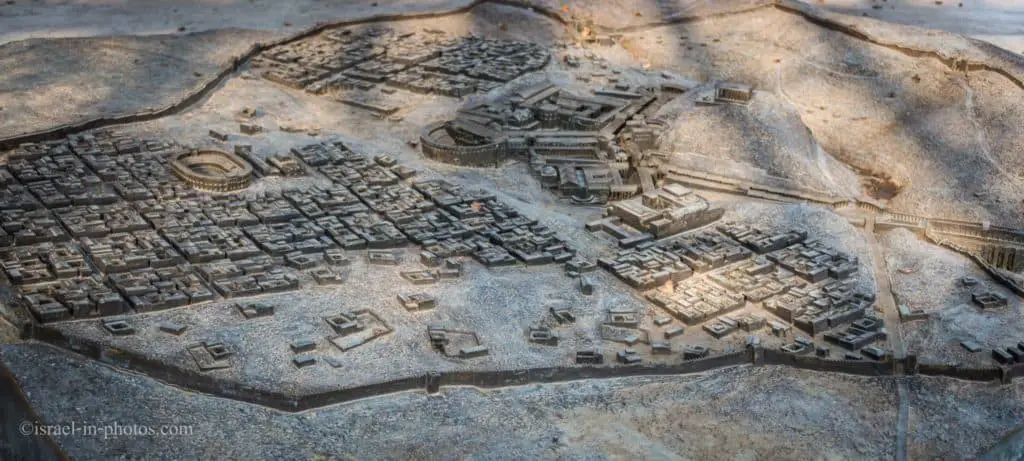
The entrance is one of the city’s viewpoints, and I shot this Panorama of the city from there.
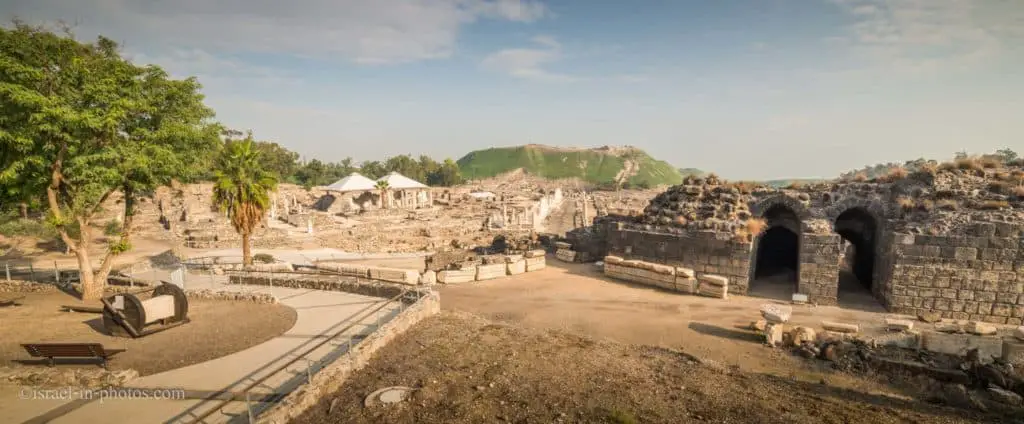
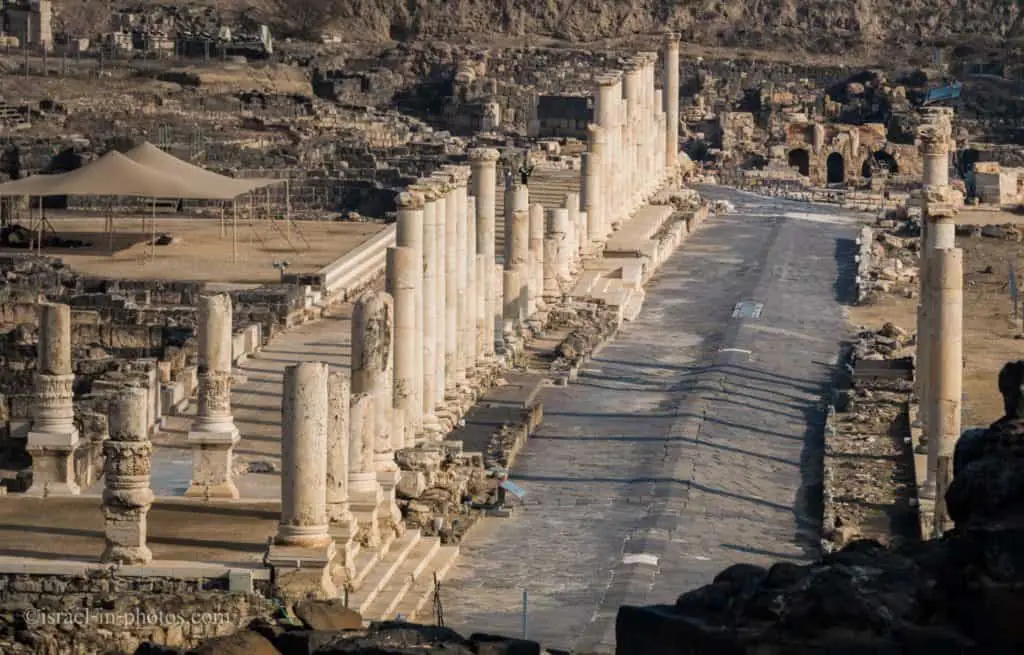
While looking at the photographs, you might wonder how the town remained in such good condition. Bet Shean is located above the Dead Sea transform fault line, and as such, it is one of the cities in Israel at high risk for earthquakes. An earthquake occurred in 749 CE. A layer of stones and ground concealed the city. Thus, for centuries, nothing was touched (of course, the standing pillars are part of reconstruction).
Roman Theater
The theater is one of the most impressive structures (number #1 on the map).
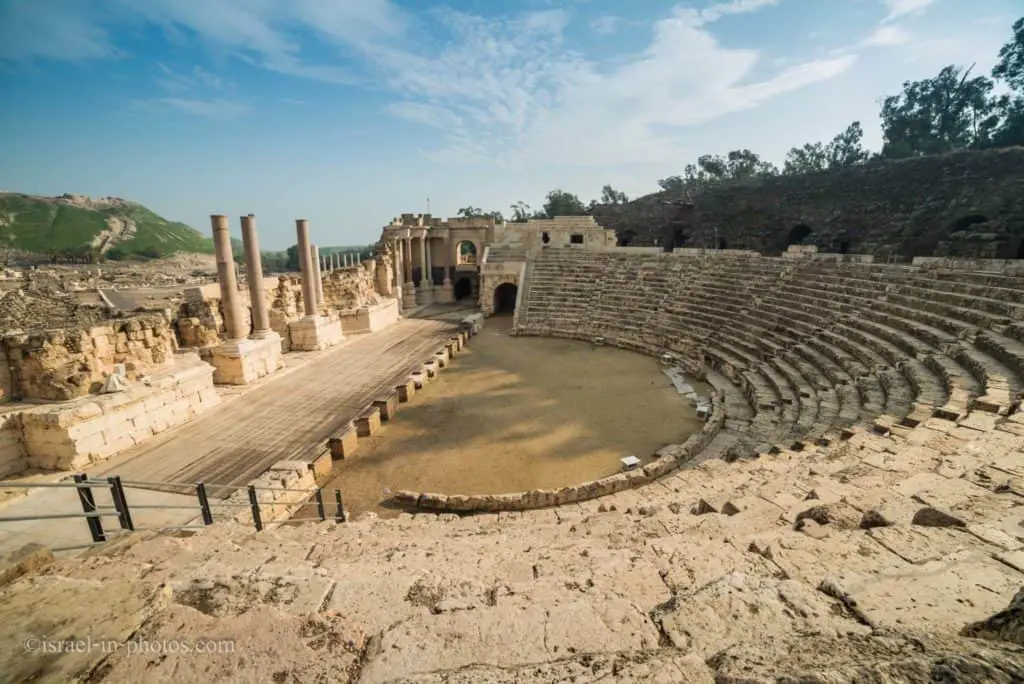
It is a 7,000-seat theater. Only the lowermost tier of seating (out of three) survived intact. Thus, we see about 2,000 seats in the photo above, and the original construction was three times higher.
As in other Roman theaters, the acoustics are phenomenal. Even if you stand on the stage and talk without a microphone, people will hear you.
Many people confuse a theater and an amphitheater. Do you know the difference between the Roman Theater and the Amphitheater? For a full explanation, check out Is Caesarea Amphitheater really an amphitheater? As you can understand from that post, Bet Shean and Caesarea National Park have theaters. The only amphitheater in Israel can be found at Beit Guvrin National Park.
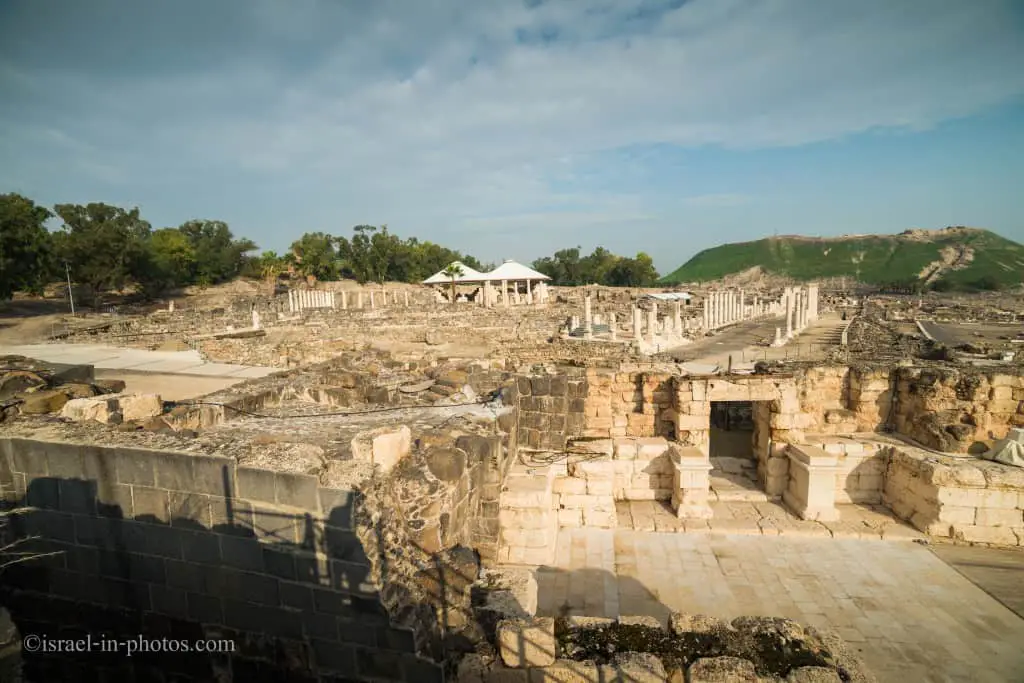
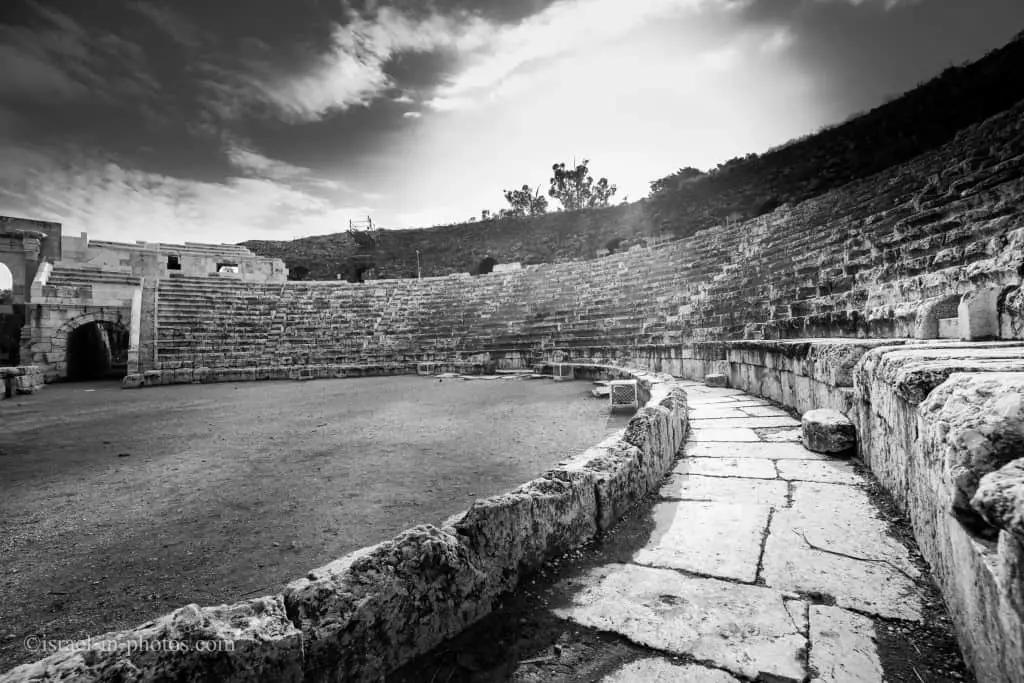
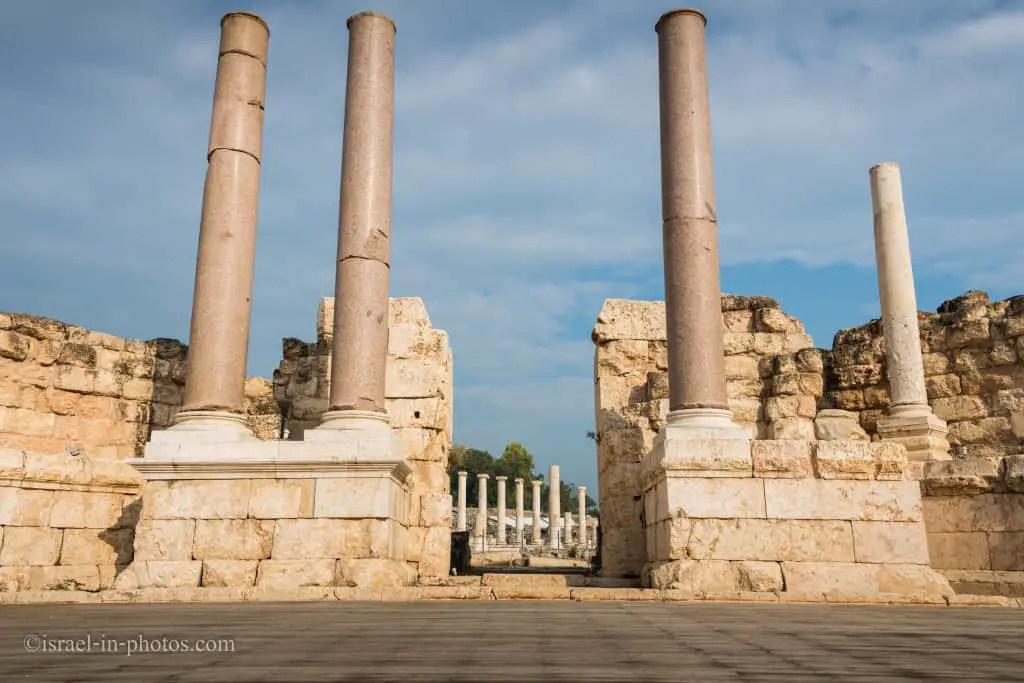
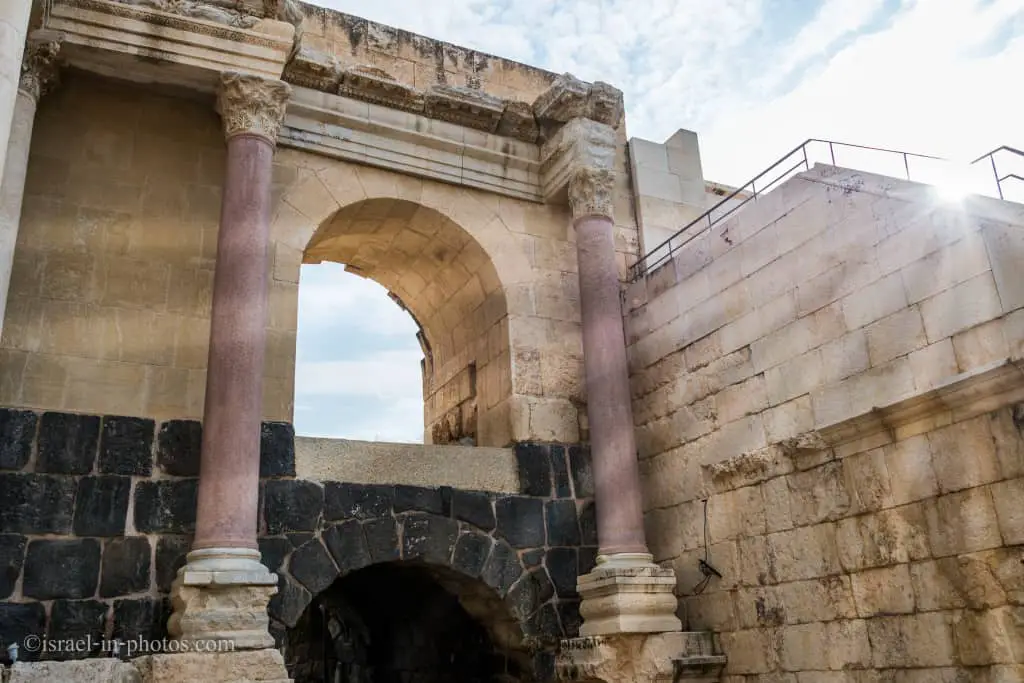
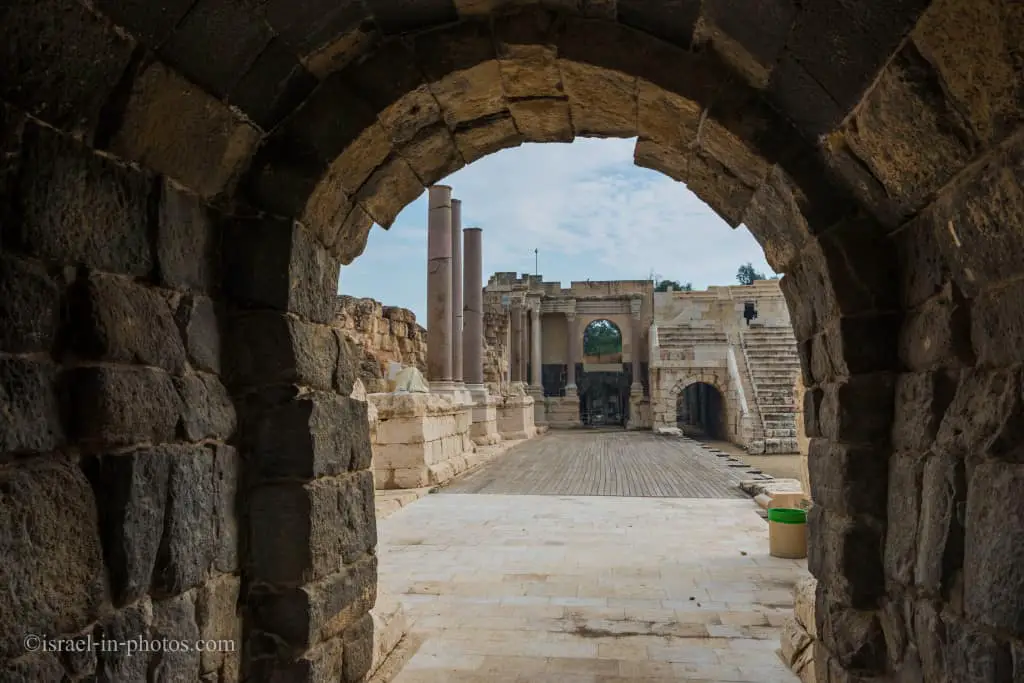
And now, we will leave the scene and go to the Western Bathhouse (numbered #2 on the map).
The Bathhouse
Before washing, it was accustomed to working out, usually weightlifting or wrestling. And the square in the photo above probably served for these workouts.
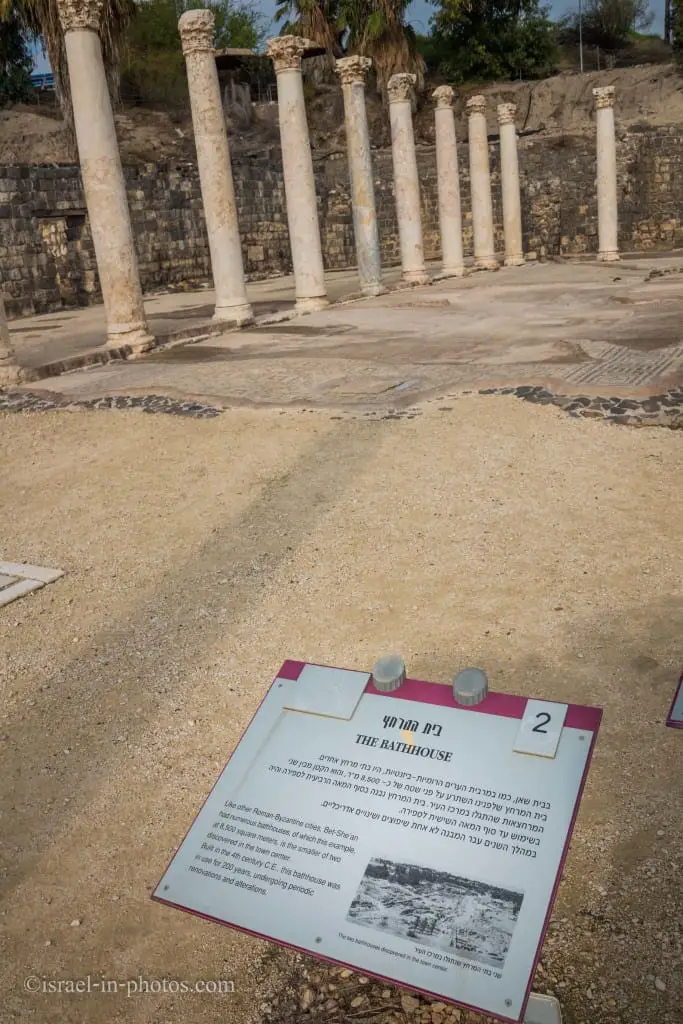
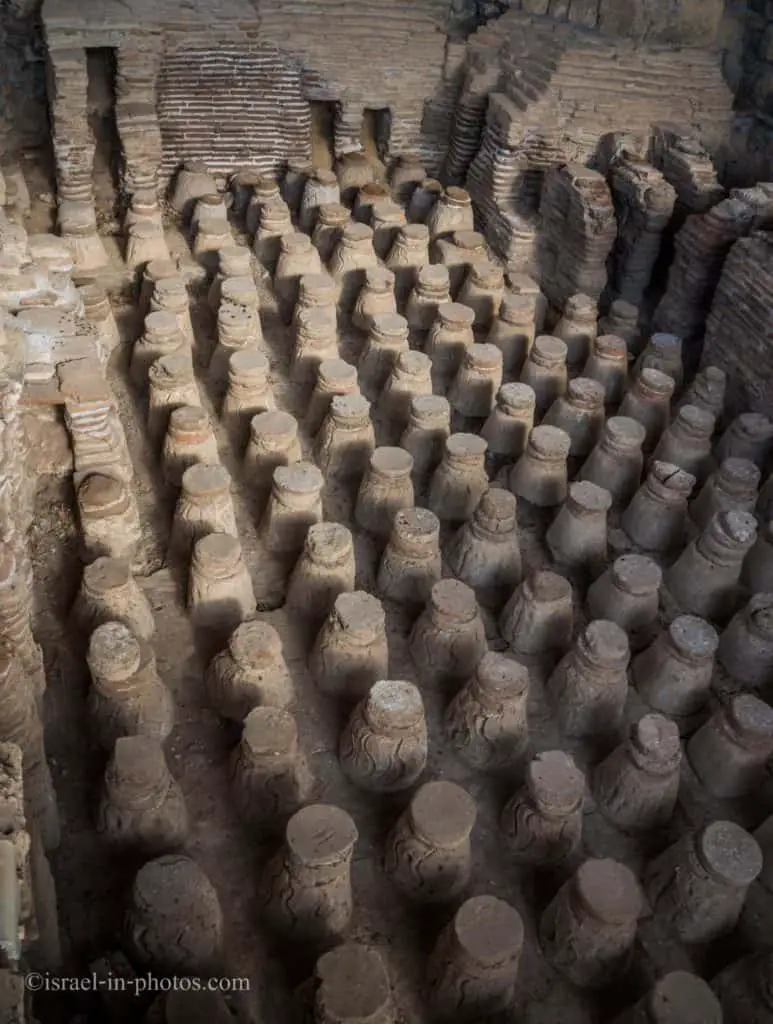
Water was heated using fire and injected inside. This circulation made the rooms above sweltering, basically a sauna.
Since they did not have soap, they covered their body with olive oil and scraped it off with a stick.
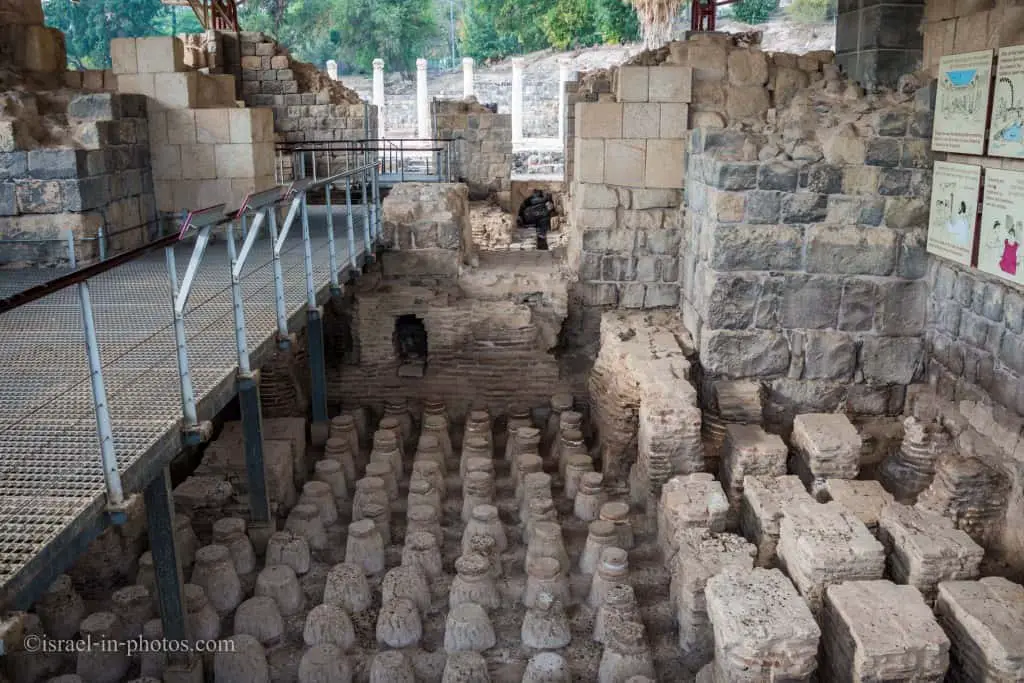
But besides the hot rooms, there are many others. For instance, they visited warm rooms (for relaxation purposes) and cold plunge baths after hot places.
Also, on the premises, there are many small rooms. Masseurs and hairdressers could have used them.
The large bathhouse was built at the end of the 4th century CE and was in use throughout the Byzantine period. It is 100 m long and 90 m wide. The bathhouse had a courtyard surrounded by porticoes, with rooms facing into it on three sides, from the outside, most of them paved with mosaics of colored marble tiles. The central courtyard served as a palestra – a place for physical exercise. Inside the bathhouse were eight halls and four open bathing pools, surrounded by columns. Fountains stood between the pools.
Note: unless stated otherwise, all quotes were taken from the official site.
Palladius Street
It is a 150-meter-long colonnaded street.
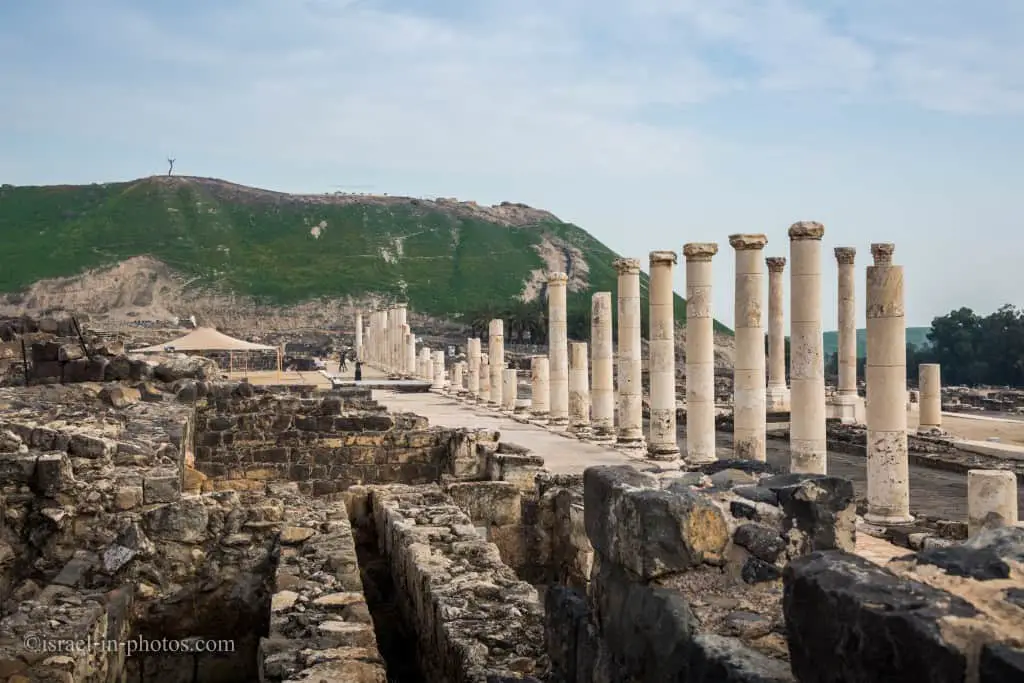
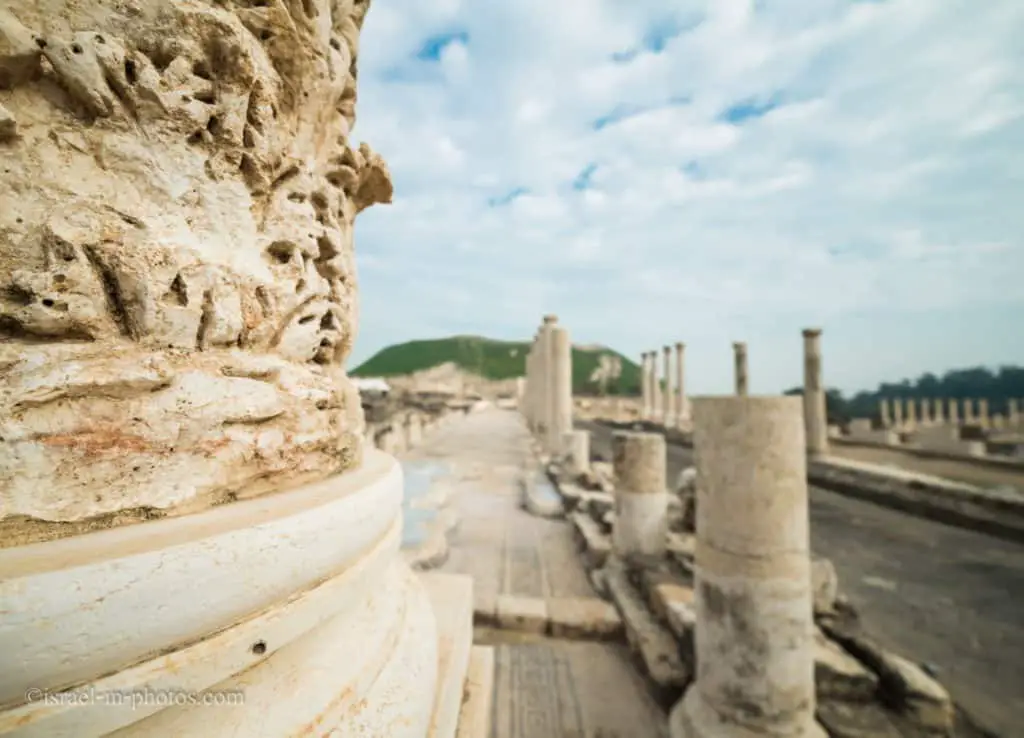
On its northwest side, a covered patio opens into a row of shops. A dedicatory inscription was found in the portico mosaic. The inscription recounts the construction of the portico in the days of Palladius, governor of the province. Thus, this street was named Palladius.
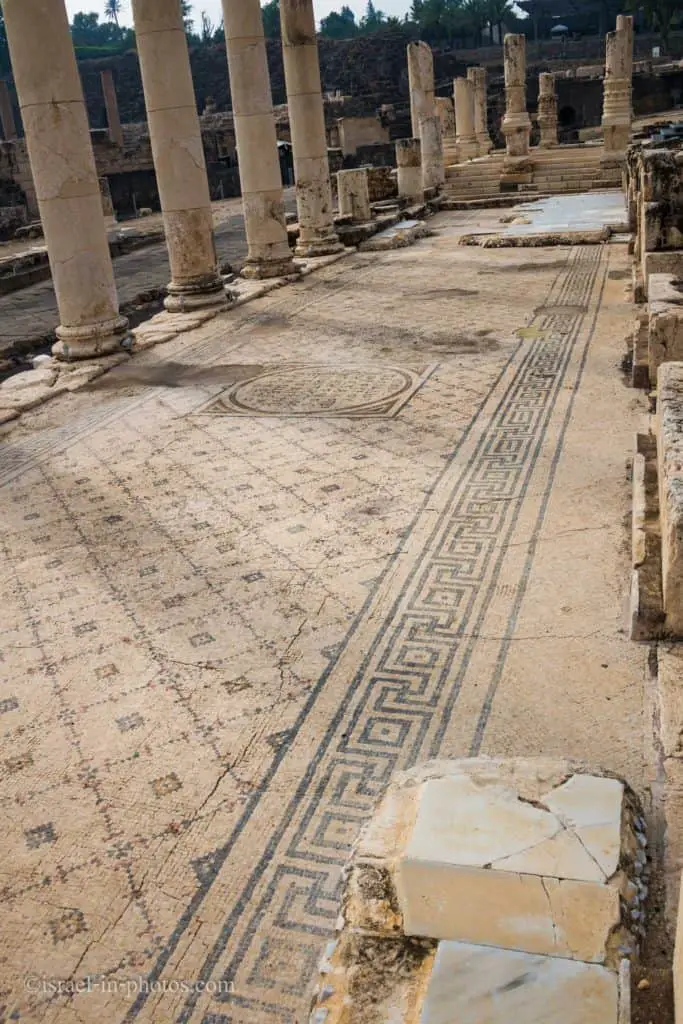
Weather-Related City Planning
I took the following photo from a low angle to show the slopes. There are two slopes, one to each side, and a functional drainage system. Many modern towns in Israel have a drainage system that is worse than the Romans. And all this even though Bet Shean does not get much rainwater (average annual rainfall is 344 mm annually).
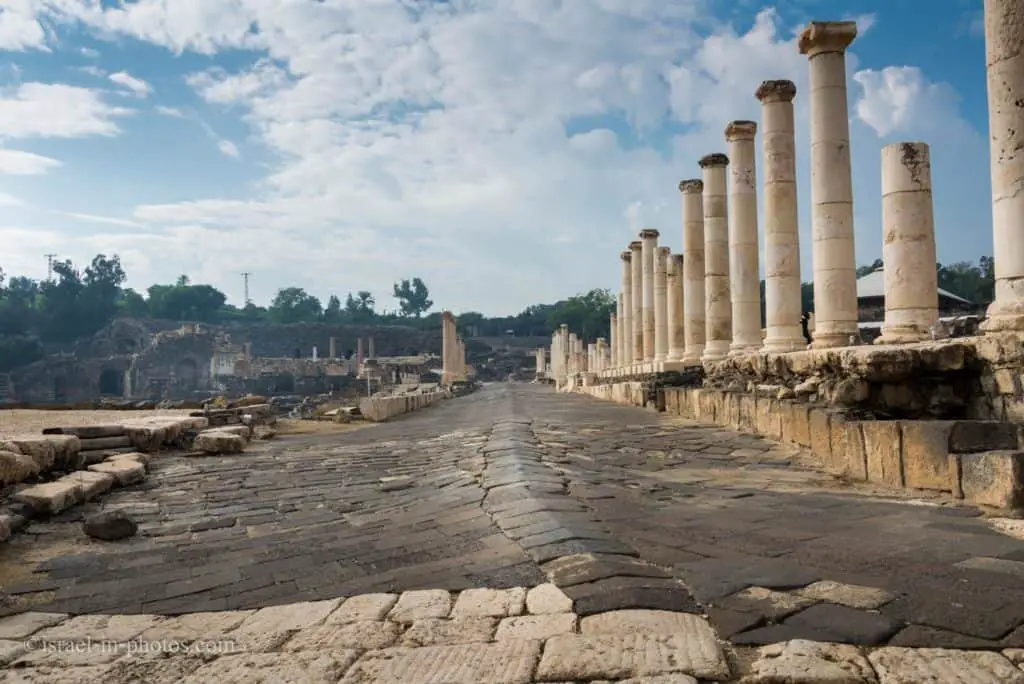
If I mentioned the weather, I should also say it is hot in this area. Thus, the streets in Beit Shean were straight. Straight roads allowed better wind circulation throughout the city. And again, most modern cities in Israel do not use this simple technique. Only in the last couple of years have there been talks of how the street’s shape and its buildings affect the wind (mainly regarding skyscrapers built along the coastline in Tel Aviv).
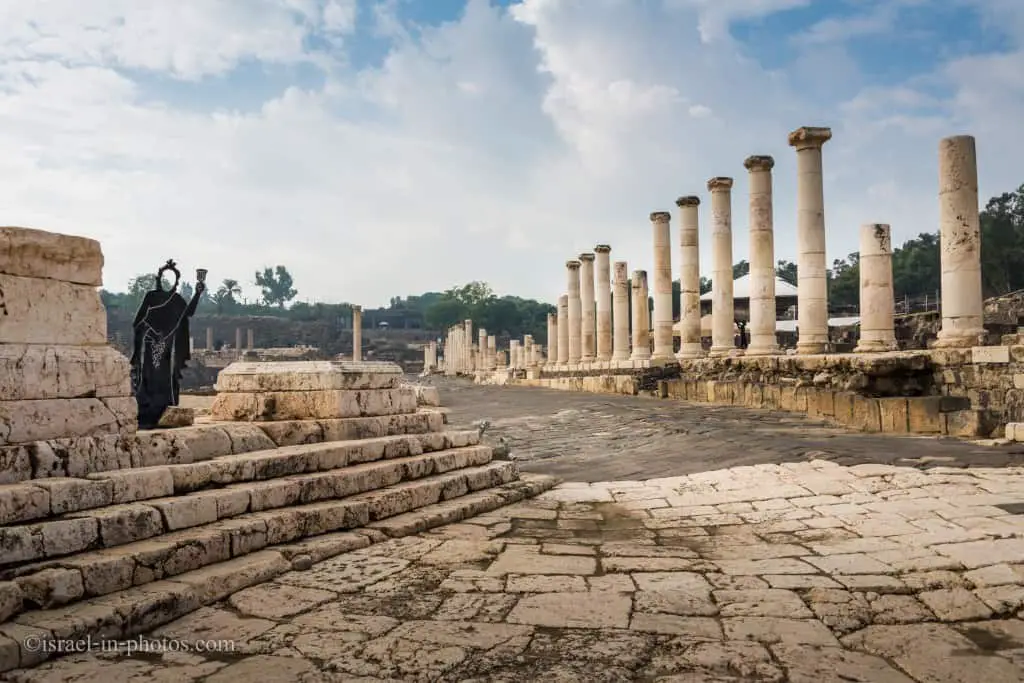
That is quite amazing. Although the middle part of this column does not touch the ground, there is grass there. Survival mechanisms are fantastic.
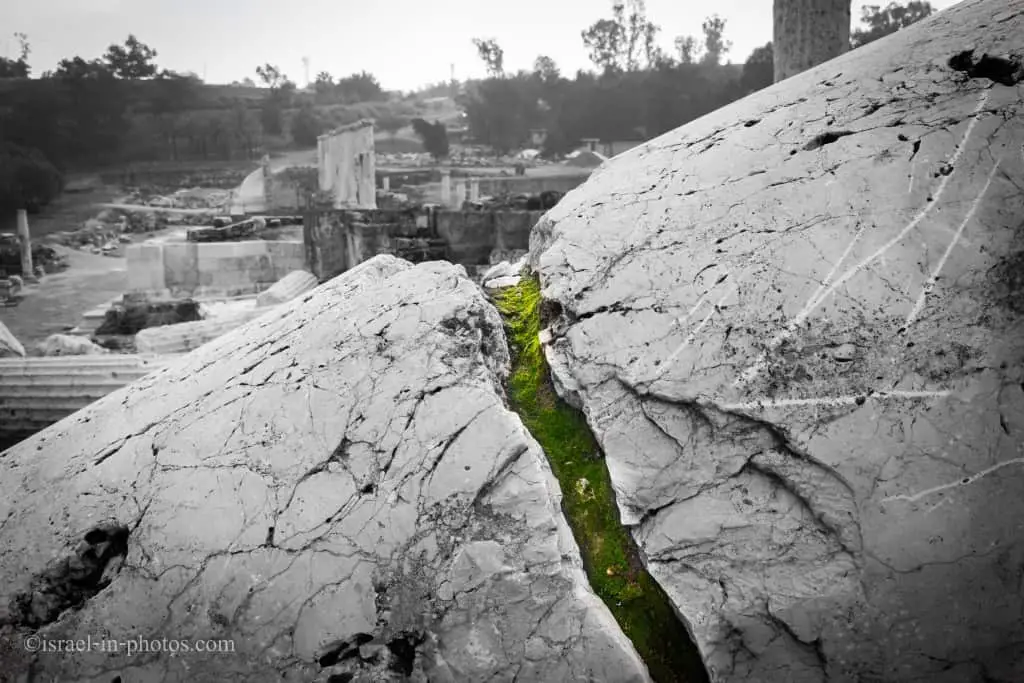
Silvanus Street
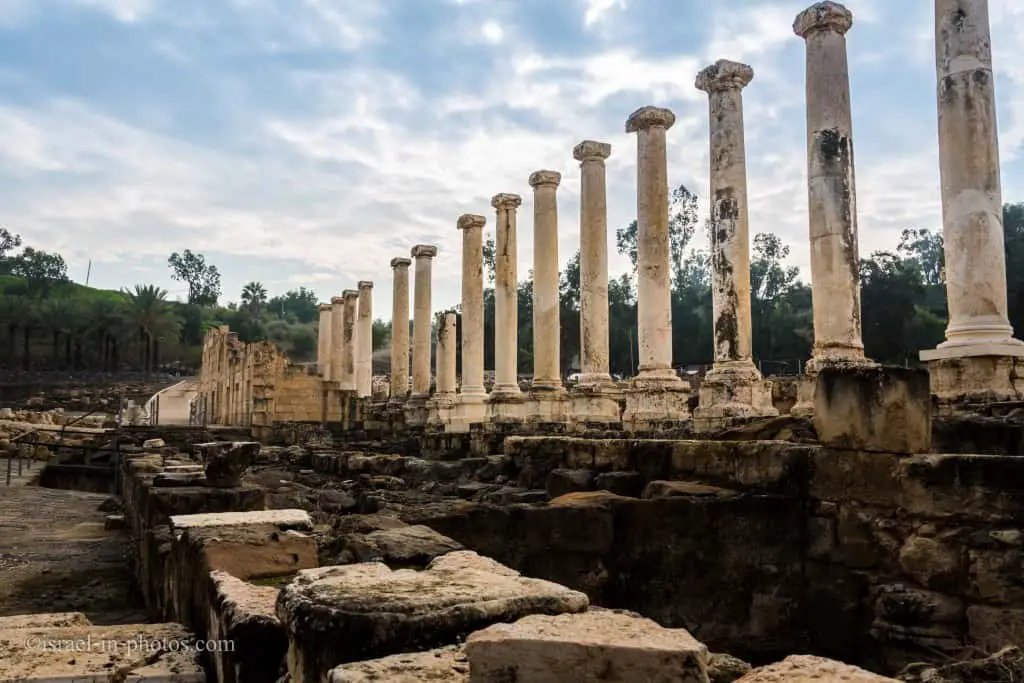
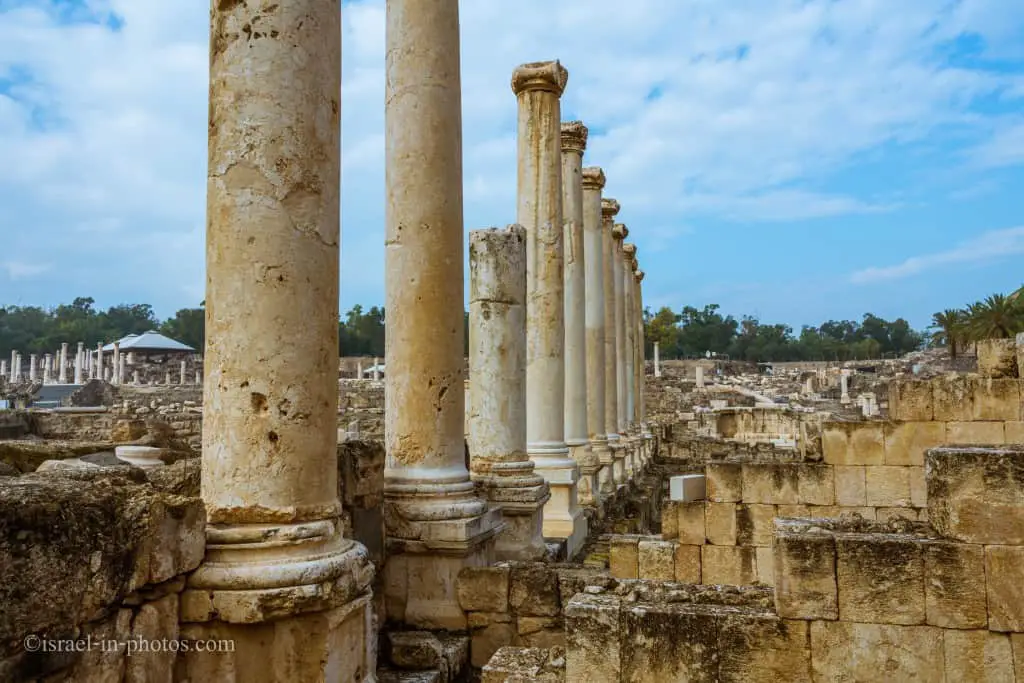
Tel Beit Shean
I took Valley Street to climb Tel Beit Shean, also known as Fortress Mound.
If you want to learn what the word Tel means, check out my guide about Megiddo.
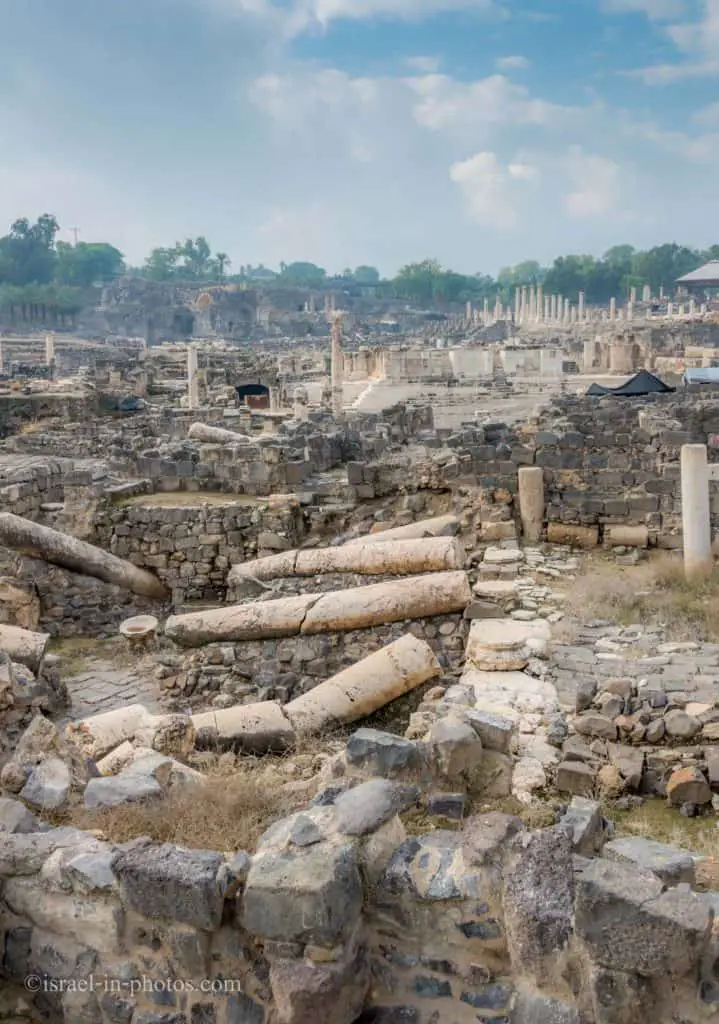
After a couple of dozen stairs, you reach a viewpoint where you can find models and drawings demonstrating the appearance of some of Silvanus Street’s buildings.
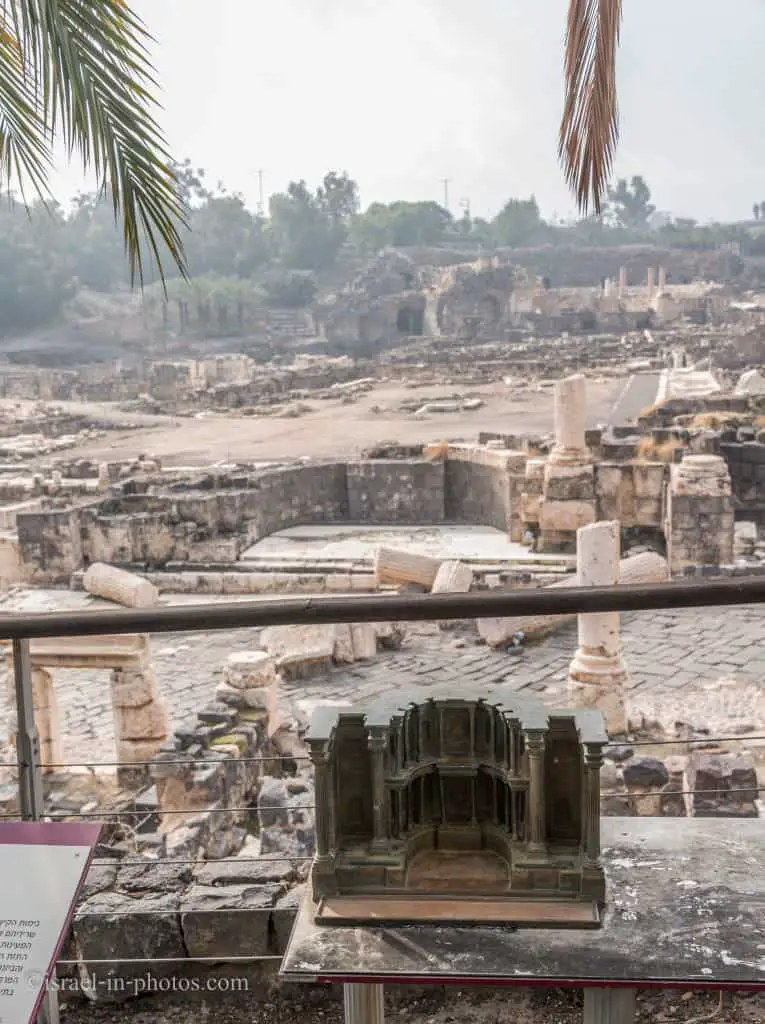
In the following photo, you can see the model and the remains of Nymphaeum (numbered #8 on the map):
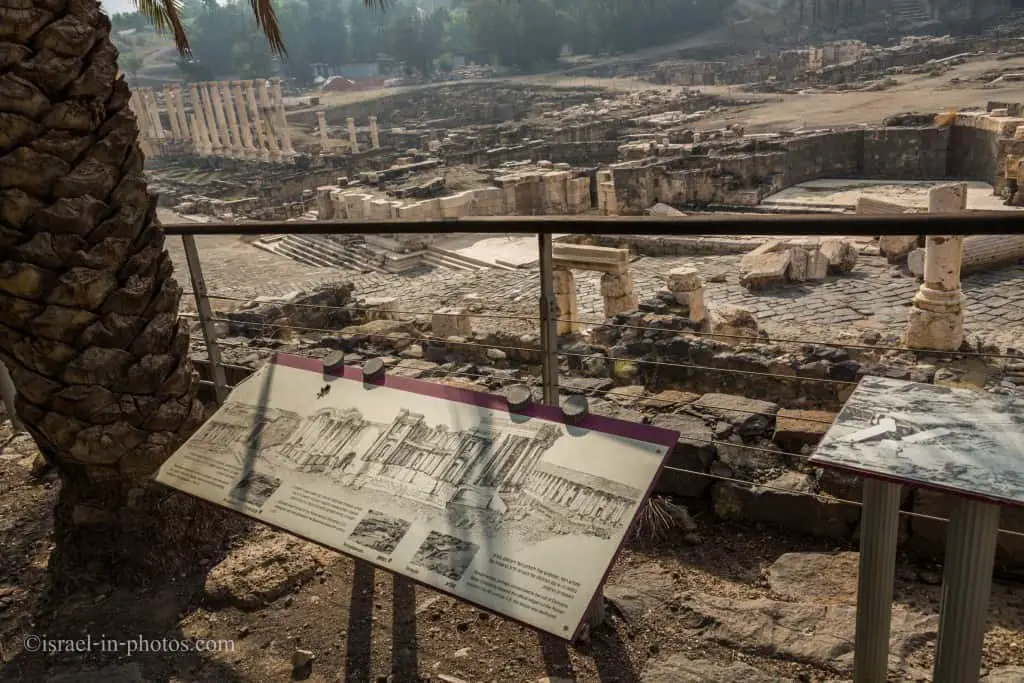
Nymphaeum is a public fountain from the 2nd century. As you can see in the model, a pool was in front of the building. Water spilled on it. Also, decorative elements were found on the site, and incorporation will be made in the future.
From there, I continue the climb, and you can see my previous spot (next to the Palms).
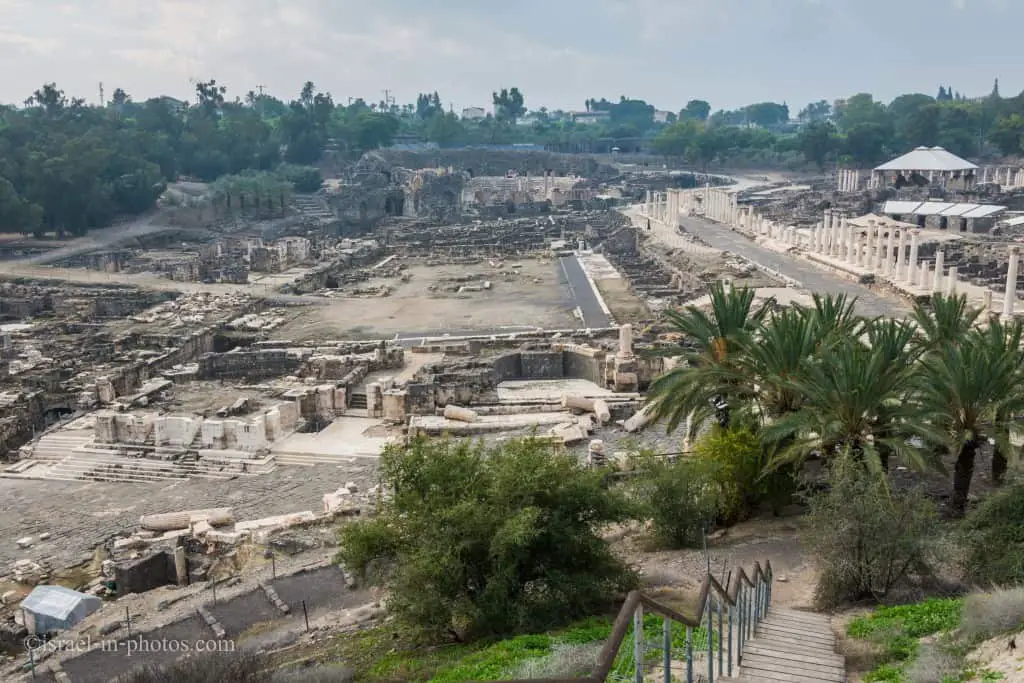
Little Bee-eater
While you climb, you will see many small holes in the sides of the mountain. I thought maybe birds were in them, and after several minutes, I saw two guests.
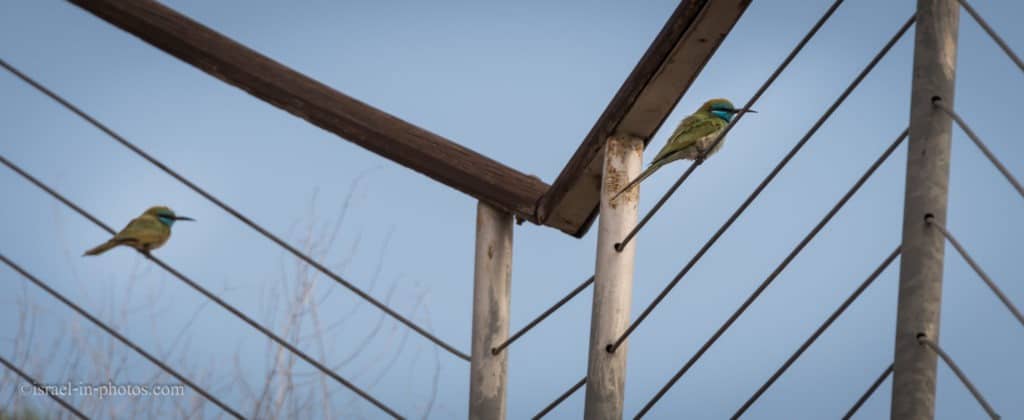
Little bee-eater reaches a length of 15–17 cm, which makes it the smallest African bee-eater. Unlike other bee-eaters, these are solitary nesters, building tunnels in sandy banks.
If I mentioned birds, there are many storks in this area. While on-site, I saw stork thermals above Tel Beit Shean. But unfortunately, I was far away at that moment. A bird-watching center in Kfar Rupin (their site) is only several kilometers away.
Almost at the top:
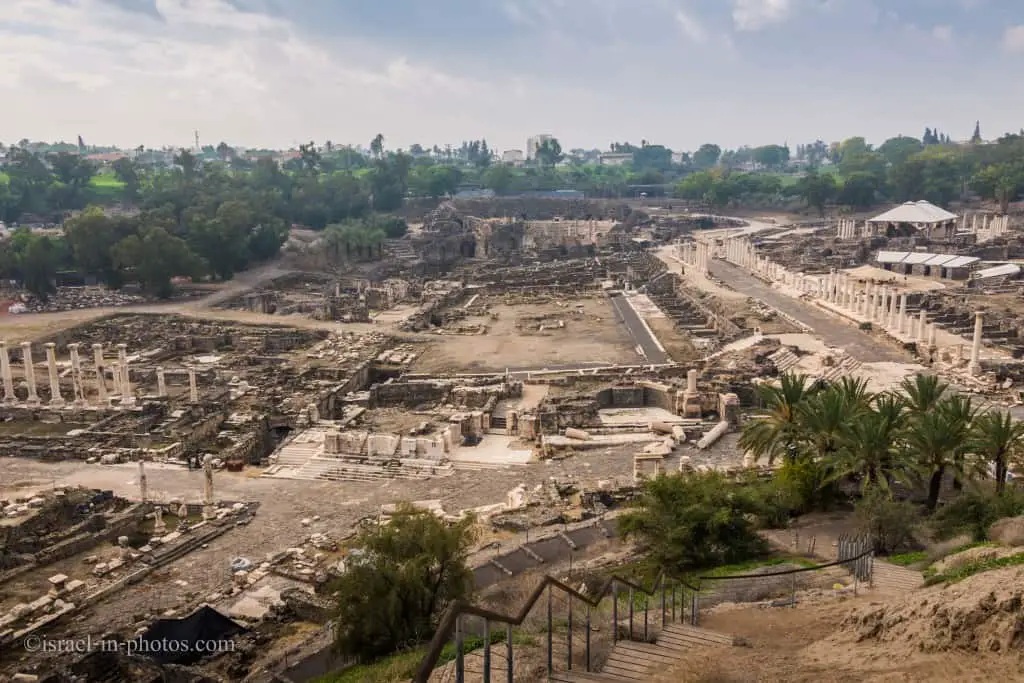
From the viewpoint on the top of the Tel:
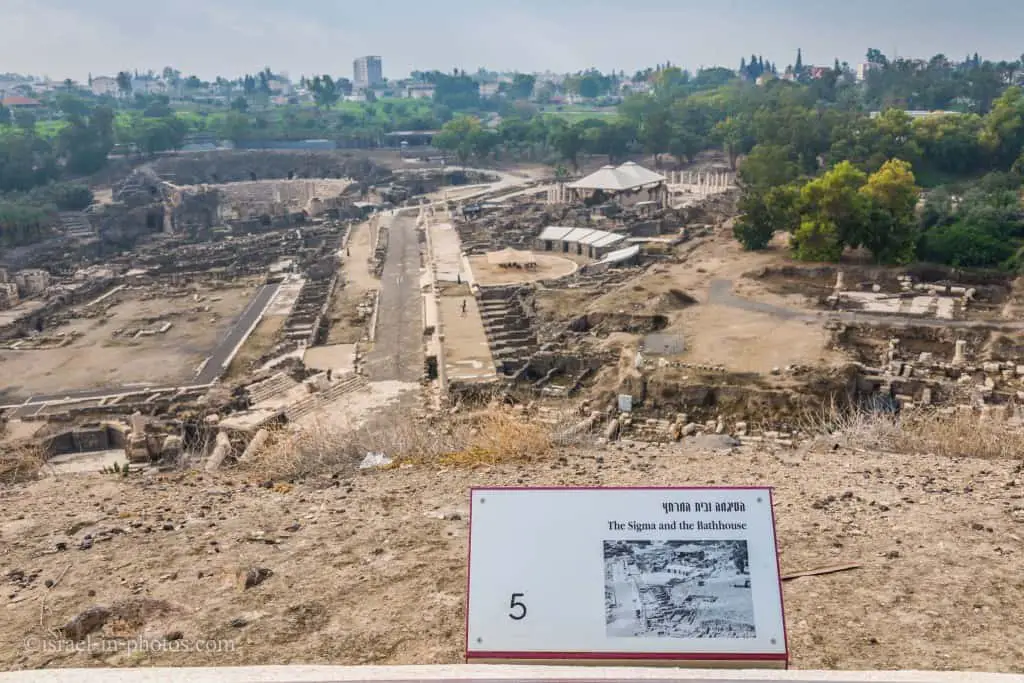
Modern and Ancient
According to the Central Bureau of Statistics, in 2013, Beit Shean’s population was 17,263. And the inhabitants of Scythopolis reached 40,000-50,000 people. One of the guides (a city resident) told us: “We do not want empty slogans from politicians. We want Bet Shean to reach the same size as Scythopolis.”
Before an earthquake destroyed ancient Beit Shean, 40,000-50,000 residents lived there. But you see only a tiny part of that city today. Archaeological studies show that there is still more underground than discovered. Restoration and digging continue. And every time I visit there (on average every several years), I see new additions. Unfortunately, there is not enough money, so work is done slowly.
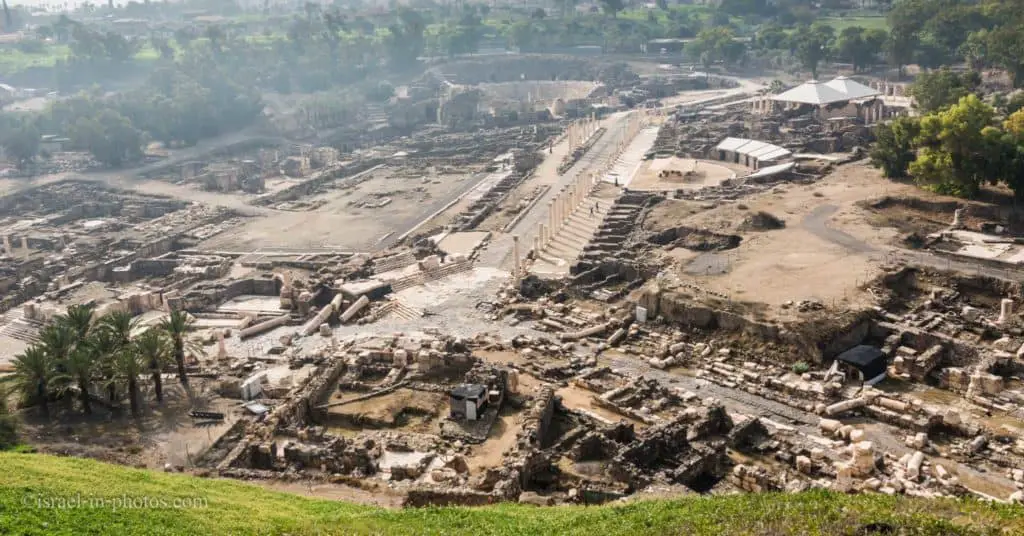
You can see the modern city above the ancient one. There are documented cases where residents wanted to build new shelters or storerooms, and when they started digging, they found remains of the old city. But, as I mentioned, there is insufficient funding, and such findings are usually on hold until better times.
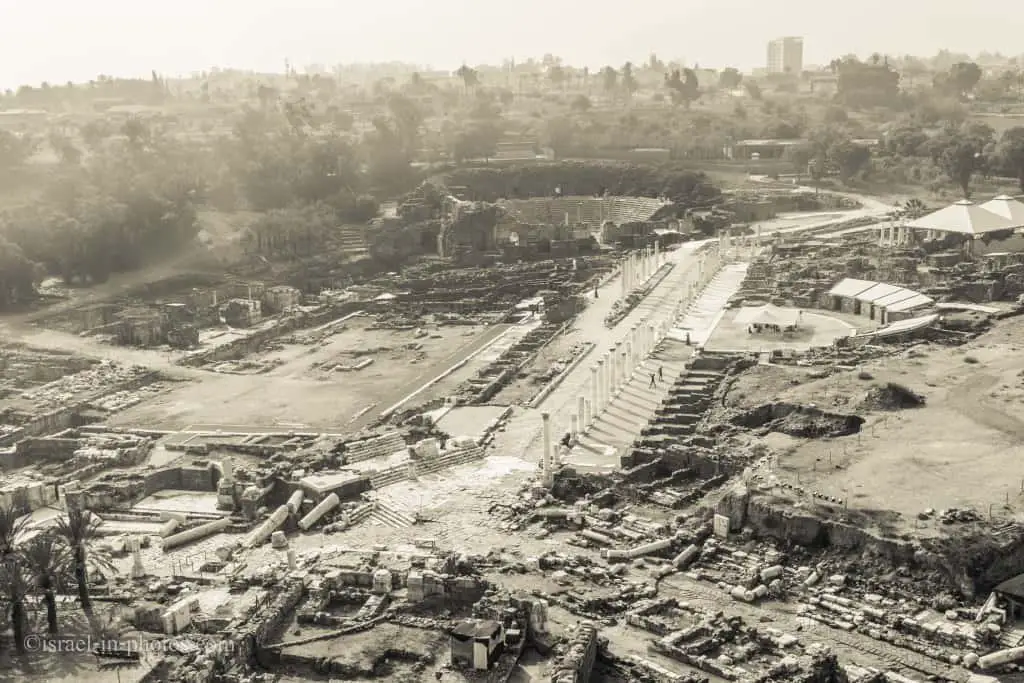
You might think that the Tel (mound) has only viewpoints, but this is false. Archeologists uncovered twenty settlement strata, the most ancient from the 5th millennium BCE and the most recent from medieval times.
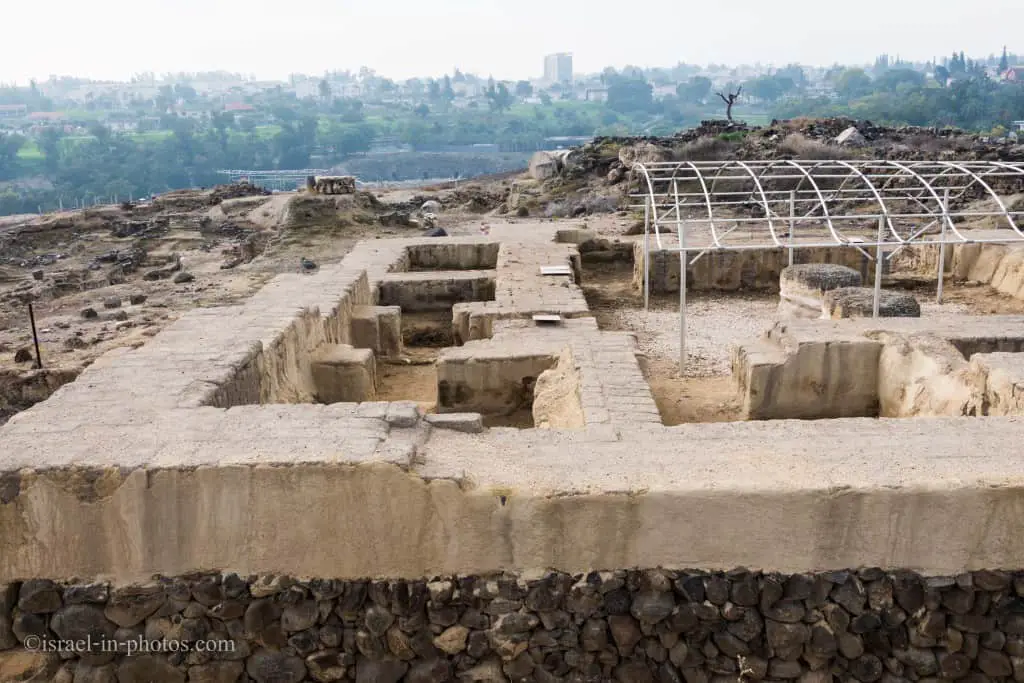
Best preserved is the Egyptian governor’s house:
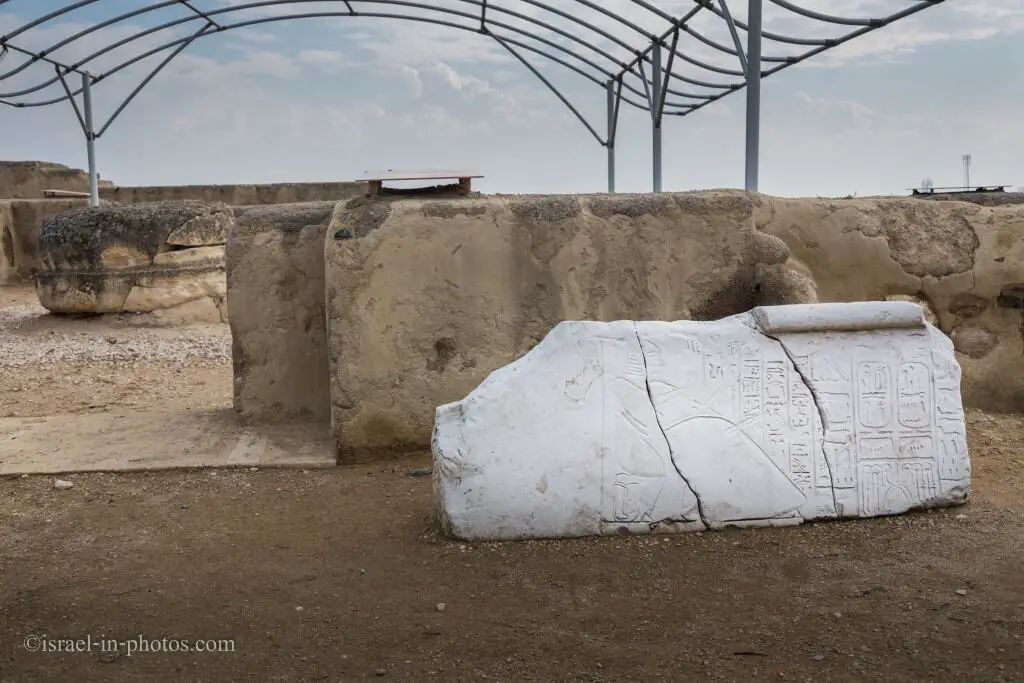
The last view from the top, and let’s go down.
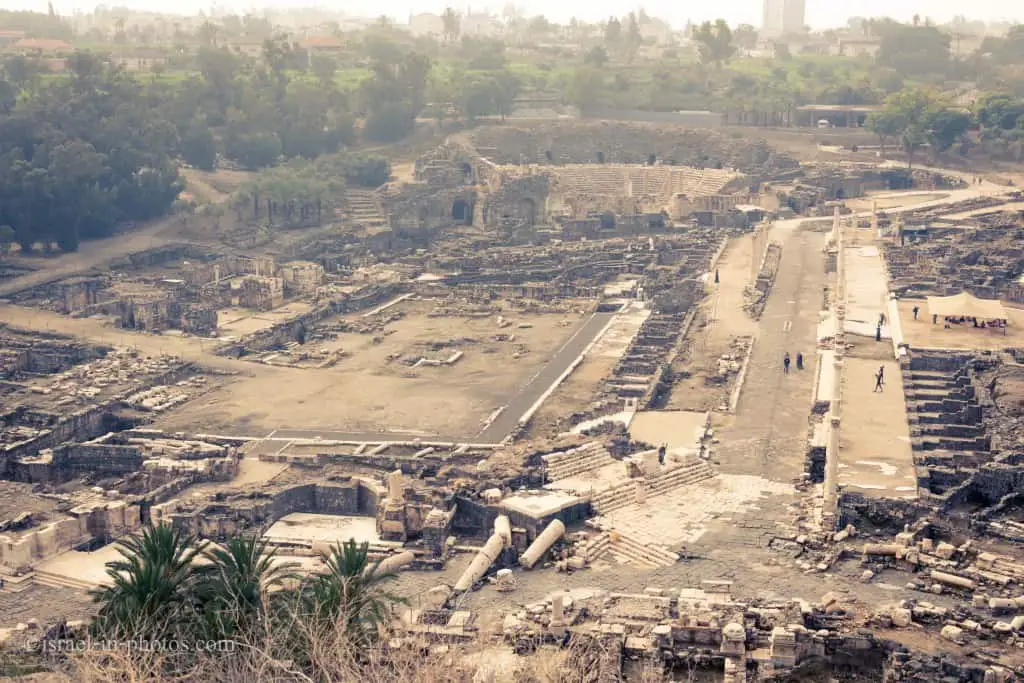
Getting Down from Fortress Mound
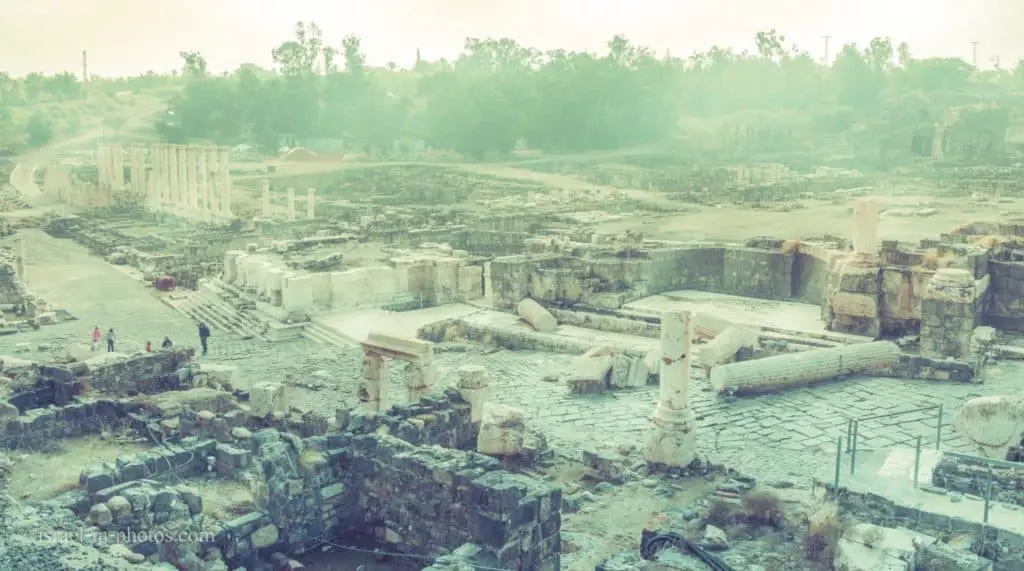
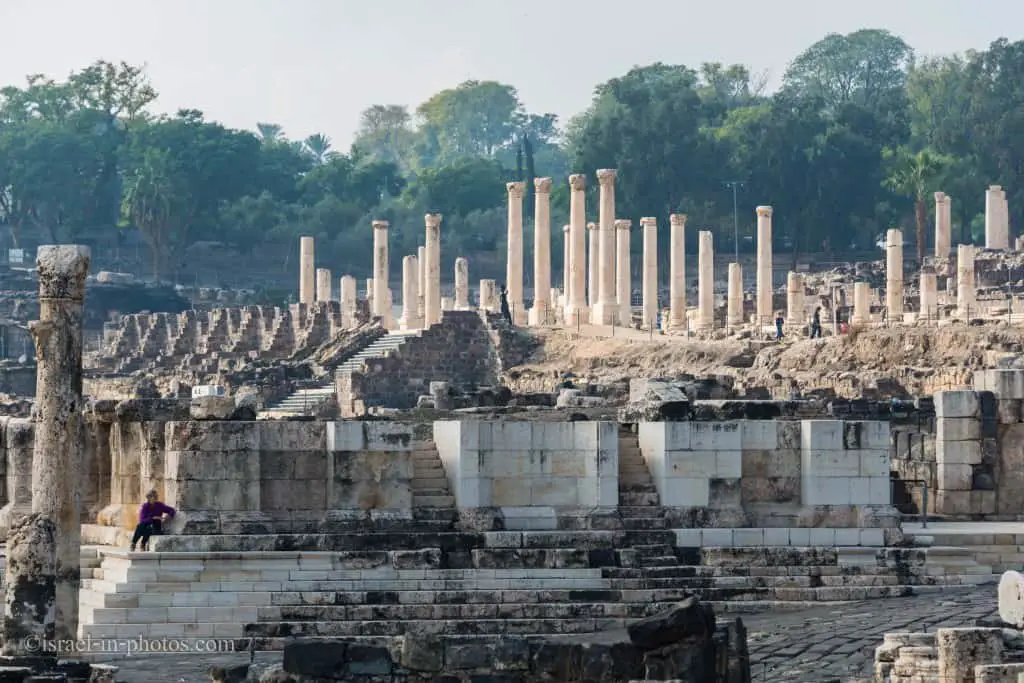
I have incorporated a woman in the photo above to give you a sense of scale.
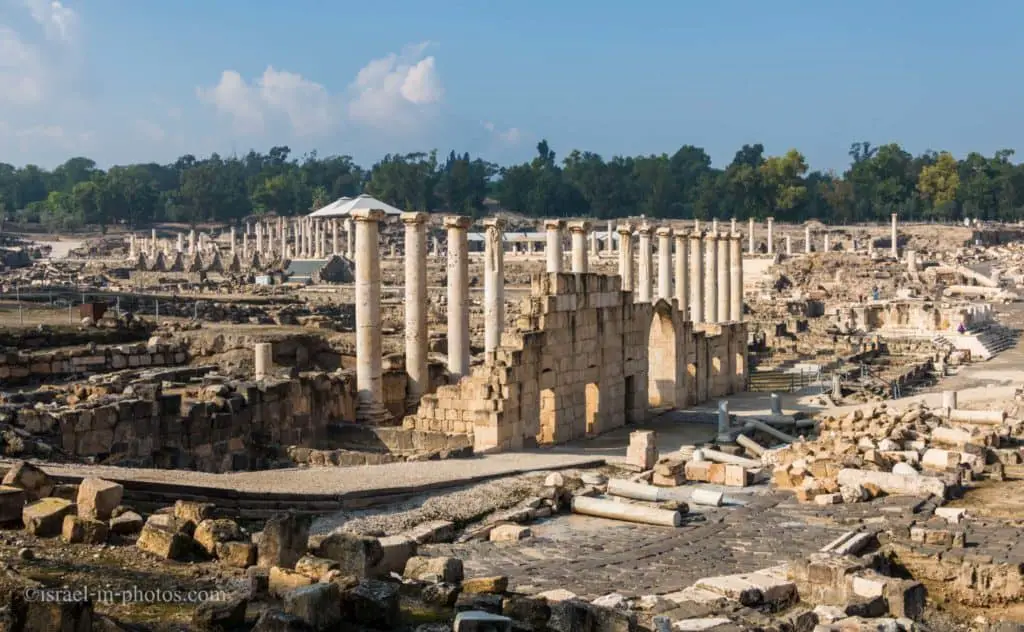
The next building (numbered #13 on the map) is fascinating, probably because it looks strange by today’s standards. Try to guess what it is.
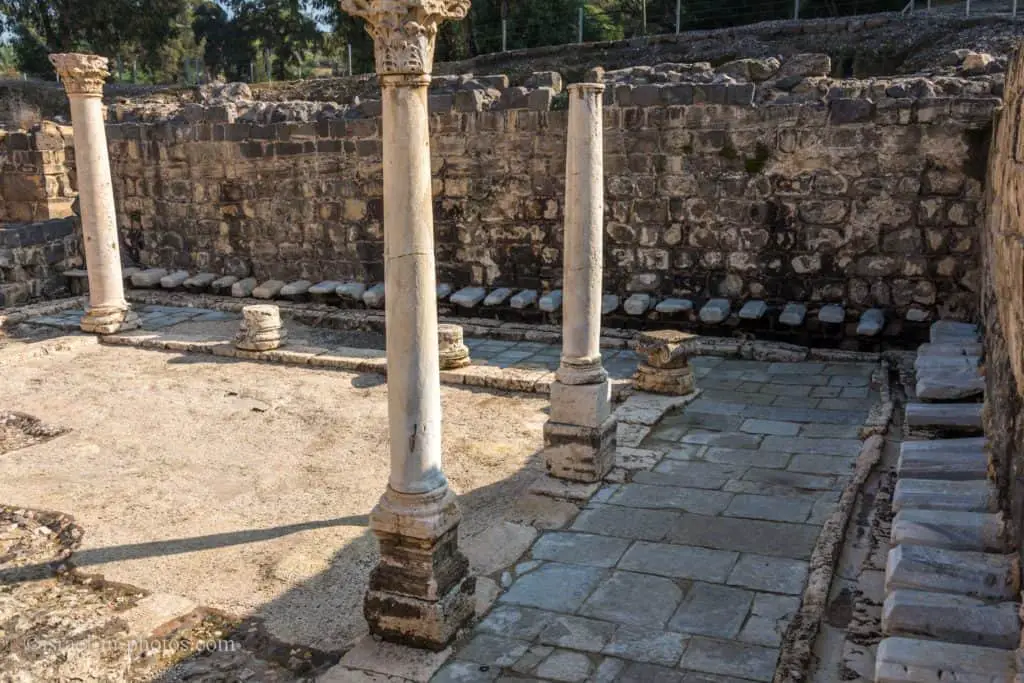
Public Lavatories
The photo above and below shows public lavatories. These public toilets are located next to the theater.
As you can see in the picture above, there is a small courtyard with columns. That is the waiting area. If there were no empty places, people waited and sometimes used this area to close deals.
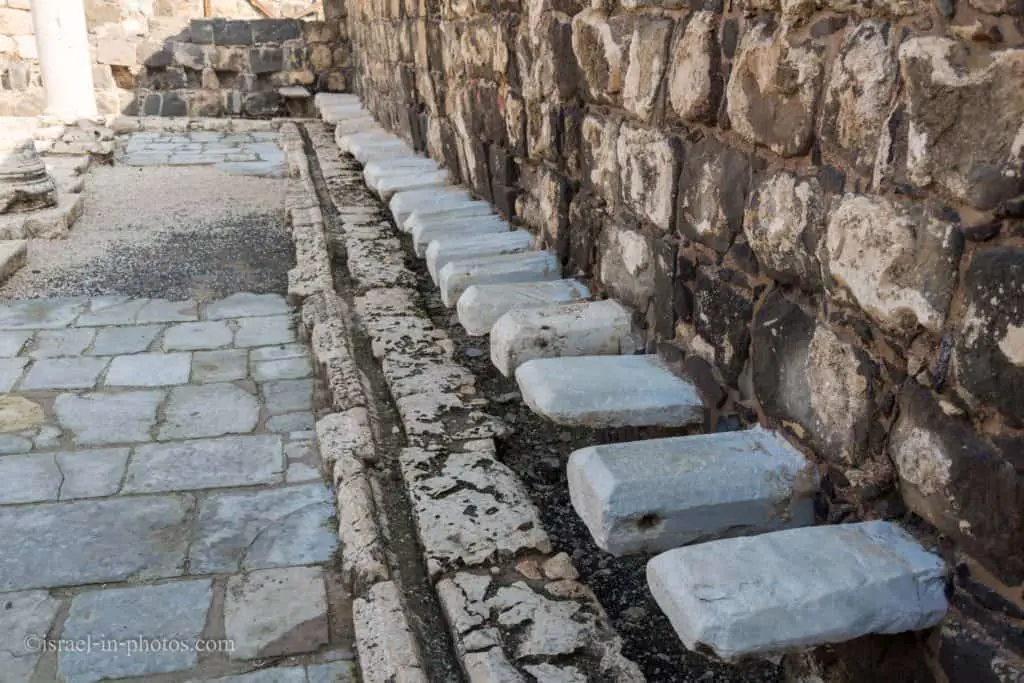
The photo below gives a closer view of the sitting places, but the exciting part is the water system. There are two different “pipes”: one straight beneath the sitting places, and the second one is much narrower in front of them. Residents used the second one to wash their hands. I used the word “pipes” to emphasize that there was always running water.
Sacred compound (numbered #14 on the map):
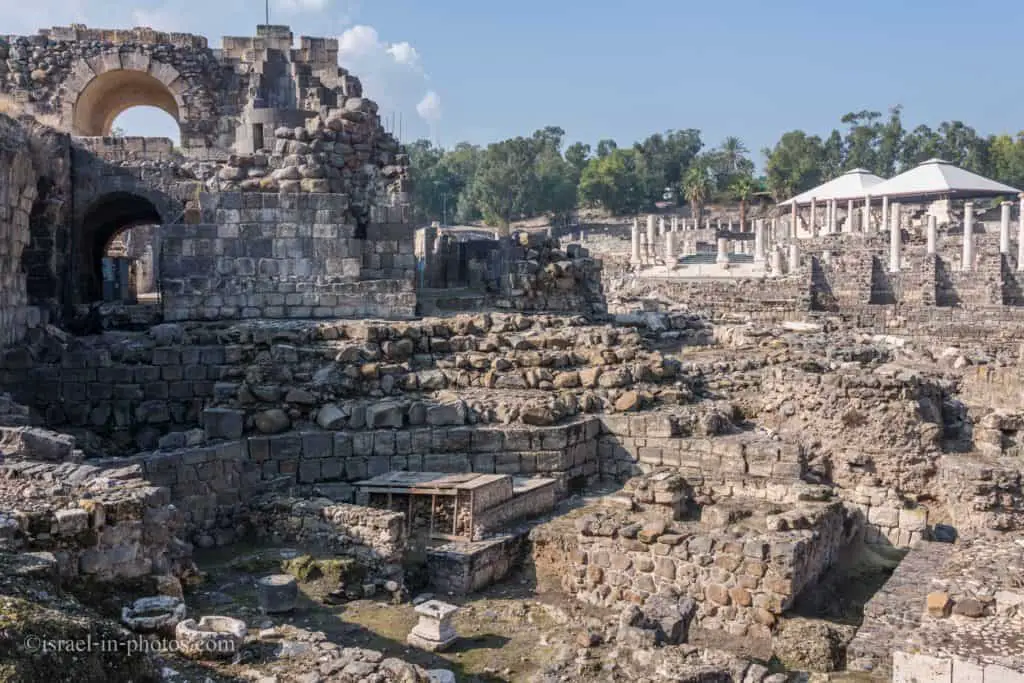
And back to the theater.
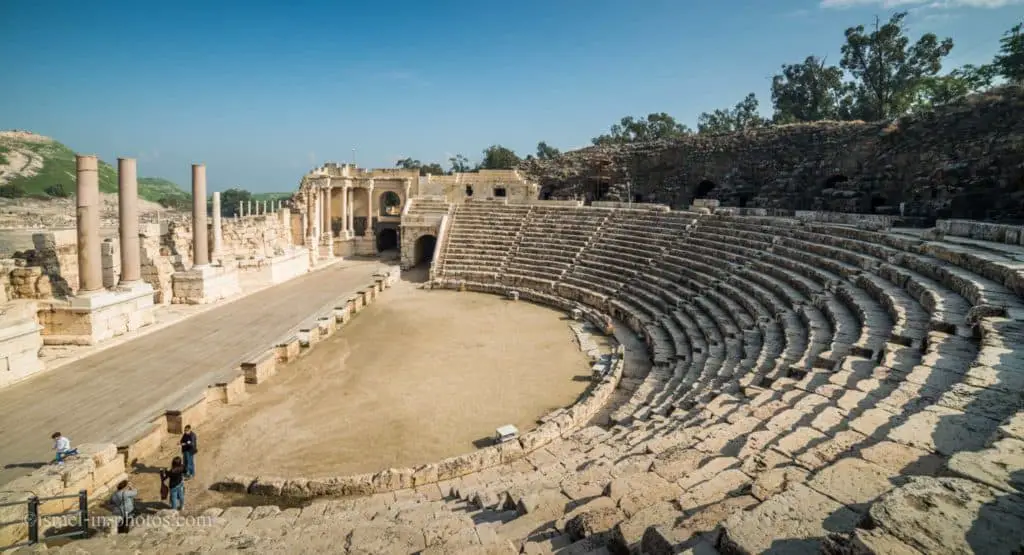
That ends our loop trail. Before talking about Beit Shean Nights, I wanted to give some time estimations. If you are doing an overview tour (without climbing the Tel), completing the trail will take about 1 – 1.5 hours. And if you are doing a more in-depth visit, it will probably take 2.5 – 3.5 hours.
Shean Nights – The Light Show
As I mentioned, it is usually hot during the day in this area. But during the night, the weather is pleasant. I’m not sure if the weather is the main reason, but a new audiovisual display was created several years ago. It is called Shean Nights.
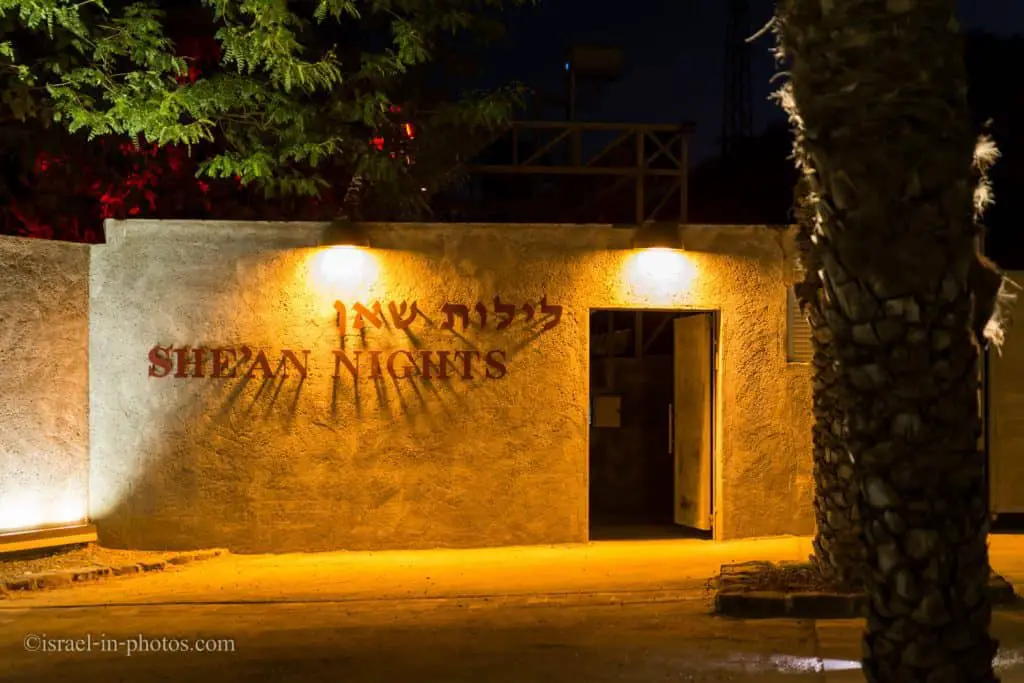
Note: the official name is Shean Nights, but many call it the Night Show or the Light Show.
Since the Shean Nights show is quite popular, you have to call the Israeli Nature And Parks Authority in advance and make a booking. Their phone number is 04-6481122, and their e-mail is Lelot_s@npa.org.il. For additional info, see this page.

Shean Nights starts with a short movie about the history of Beit Shean. The film was projected on the theater’s back wall.
Then, a guide arrives, and you start the tour.

I arrived at Shean Nights with a tripod. And one of the workers asked me to hand in the tripod for our visit. So, photography is allowed, but if they suspect a “professional photographer,” they might ask you to stop. I asked our guide about it, but he was unaware of any policy.
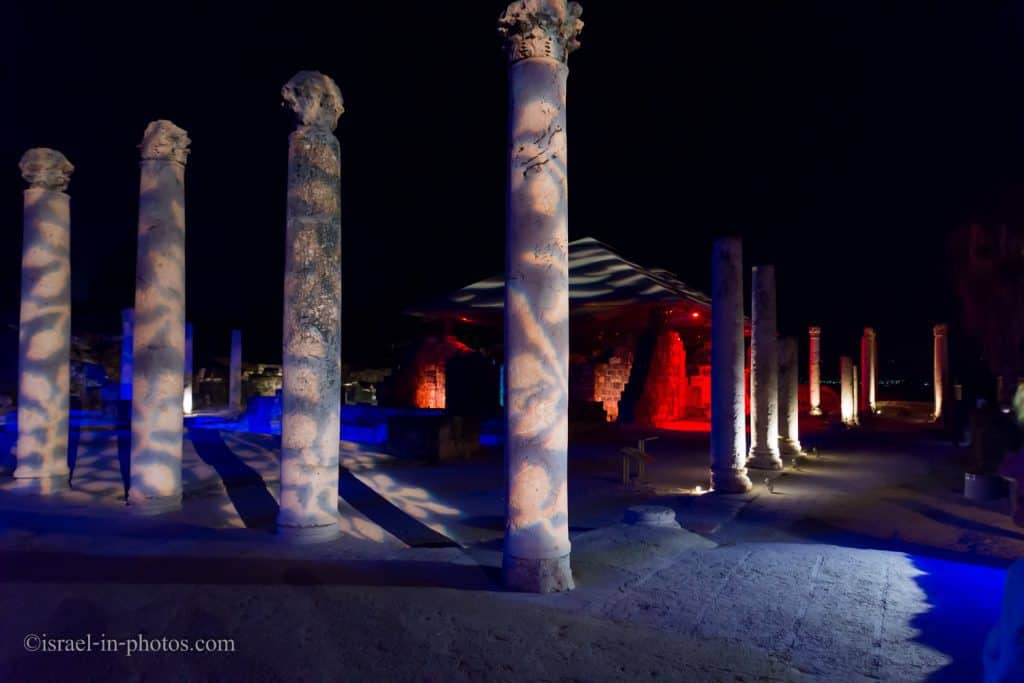
The tour goes around the loop trail, similar to the one I mentioned above. With one change, it starts from the bathhouse and ends in the theater.
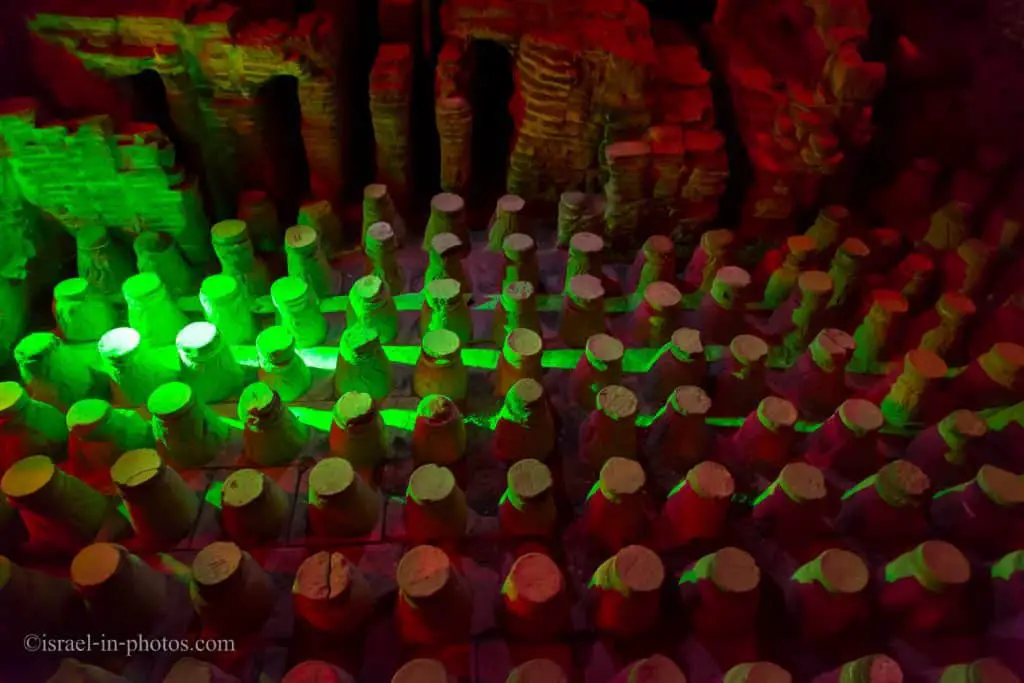
Also, you do not climb the Tel, as there is no light.
And here are several additional photos from Shean Nights.
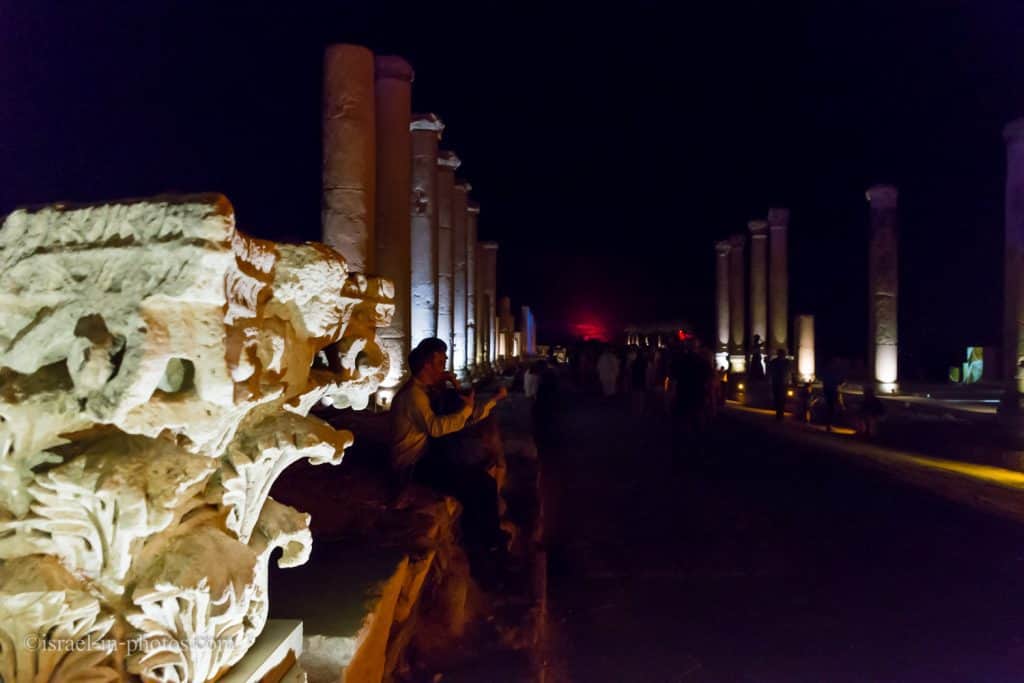




The tour usually lasts about an hour. And that was the duration of other tours during our visit. But since our guide saw we were enthusiastic about the subject, he made it longer, almost two hours.
Overall, Shean Nights gives a lovely, short overview tour during the colder hours of the day, but it is too short for my liking.
What Does Beit Shean Mean?
I was interested in this question, and even after investigating, I did not find a clear answer. While researching, I found several different possible explanations. And here are the two most common:
- According to English Wikipedia, Shean relates to the modern word Sheannanut. Thus, Beit Shean means “House of Tranquillity.”
- According to Hebrew Wikipedia and biblewalks.com, Shean was probably the name of an ancient god. Hence, the name “House of Shean” probably refers to an ancient temple to the Shean god on this site.
Beit Shean In The Bible
Beit Shean is mentioned several times in the Bible. For example, at the battle of the Israelites against the Philistines on Mount Gilboa, King Saul and three of his sons’ bodies were hung on the city’s walls.
They put his armor in the temple of Astarte;[a] and they fastened his body to the wall of Beth-shan.
1 Samuel 31:10
Here are a few additional examples:
But Manasseh did not drive out the people of Beth Shan or Taanach or Dor or Ibleam or Megiddo and their surrounding settlements, for the Canaanites were determined to live in that land.
Judges 1:27
Also in Issachar and in Asher Manasseh had Beth-Shean and its villages, and Ibleam and its villages, and the inhabitants of Dor and its villages, and the inhabitants of En-dor and its villages, and the inhabitants of Taanach and its villages, and the inhabitants of Megiddo and its villages; the third is Naphath.
Joshua 17:11
History Of Beit Shean National Park
Here is the Historical extract from the Israel Nature and Parks Authority site.
Egyptians, King David, And Alexander The Great
Beit Shean was first settled in the fifth-millennium NCE on a mound south of the Harod Stream, in the heart of a region of great fertility and abundant water, and at what became a major crossroads.
During the Late Bronze Age (16th-12th centuries BCE), the Egyptians made Bet Shean the center of their rule over Canaan. According to the Bible, the Israelite tribes were unable to capture Canaanite Beit Shean. After a battle at nearby Mount Gilboa, the Philistines hung King Saul’s and his son’s bodies on the city’s ramparts.
King David conquered Beit Shean together with Megiddo and Ta’anach, and in King Solomon’s day, it became part of an administrative region encompassing the country’s northern valleys. In 731 BCE, the Assyrian King Tiglath-pileser III destroyed the city.
In the second half of the fourth century BCE, at the time of Alexander the Great, Bet Shean was reestablished as a Greek polis, with all the trappings of Greek culture in the East: colonnaded streets, temples, theaters, markets, fountains, and bathhouses.
Nisa Scythopolis
Later in the Hellenistic period, the city was named Nisa Scythopolis.
In 107 BCE, the Hasmoneans conquered Scythopolis. The pagan inhabitants, who were given a choice to convert or leave, chose exile, and Jews resettled there, restoring the old biblical name Beit Shean. In 63 CE, the Romans took the city, transforming it into an essential member of the alliance of cities called the Decapolis.
During the Great Revolt of the Jews against the Romans (66 CE), the Jews of Beit Shean were murdered by their pagan neighbors, who took over the city and gave it back its pagan name. It developed significantly during the reign of Emperor Hadrian (117-138 CE) and Marcus Aurelius (161-180), and during the Late Roman period, Jews, pagans, and Samaritans lived together there. Magnificent public buildings were built, adorned with inscriptions and statues.In the fourth century, when Christianity became the empire’s religion, the city’s lifestyle changed again. They neglected the amphitheater where gladiators had fought, although the theater and the bathhouses continued in operation. Churches were built, but the center of town retained its pagan character for a long while.
In 409 CE, Beit Shean became the administrative region’s capital, Palaestina Secunda. The city extended to 1,300 dunams (325 acres) and prospered, mainly thanks to the linen industry, and its population reached an unprecedented 40,000-50,000.
The Decline And Reestablishment
After the Arab conquest in the first half of the seventh century, the city gradually declined, losing its hegemony to Tiberias. Then, in 749 CE, an earthquake rocked the region and devastated Bet Shean – its evidence was prominent everywhere in the excavations. The name Scythopolis was eventually forgotten, and the place became known as Beisan, recalling the ancient biblical name.
The Abbasid period saw a village established here. In the Middle Ages, settlement focused mainly on the rise to the south of the old city center, and the Crusaders built a fortress east of the destroyed amphitheater.
After the founding of the State of Israel, Beit Shean was reestablished and began to grow. The ruins, which are the city’s pride, have undergone major restoration and reconstruction, allowing special events and performances in ancient streets and theaters.
Decapolis
Decapolis, literally meaning ten cities, was a group of ten Hellenistic towns on the eastern frontier of the Roman Empire.
Beit Shean and Susita were among the ten cities. And if you want to find additional information about Decapolis, see Susita National Park (Hippos).
Nearby Attractions
If you are already in this area, then consider the following nearby attractions:
- Bet Alfa Synagogue National Park is located at a kibbutz with the same name near Beit Shean. It has one of the most preserved and beautiful mosaics in Israel.
- Megiddo National Park allows you to walk among the remains of Tel Megiddo. It is an ancient city known for its historical, geographical, and theological importance, especially under its Greek name Armageddon.
- Gan Garoo is an Australian thematic zoo in Nir David.
- Jordan Star National Park (Kokhav HaYarden) has Belvoir Fortress, an almost complete Crusader castle.
Summary
Beit Shean National Park is the best-preserved ancient Roman city in Israel. It is also a fantastic city, but remember that it is boiling in this area during the summer. Thus, I would suggest visiting Bet Shean during Spring or Autumn, preferably not during the hottest hours. In any case, take plenty of water, hats, and sunscreen.
Moreover, there are on-site guided tours, and I recommend joining them. Either check in advance or ask about tours when you buy tickets. On several occasions, when we visited on Saturdays, we saw volunteers who offered free tours.
In my opinion, Beit Shean nights are not worth the long drive as long as they keep it a one-hour show. But if you stay in the area, you can add it to your to-do list.
The bottom line is that it is one of Israel’s most impressive national parks. And it is unquestionably worth a visit.
Have you ever visited Beit Shean National Park? Tell us about your experience in the comments below.
That’s all for today, and I’ll see you in future travels!
Stay Tuned!
Additional Resources
Here are several resources that I created to help travelers:- Trip Planner with Attractions and Itineraries is the page that will help you create your perfect travel route.
- What is the Best Time to visit Israel? To answer this question, we will consider the weather, prices, holidays, festivals, and more.
- Information and Tips for Tourists to Israel will answer the most common questions tourists have about Israel (including safety, passports, weather, currency, tipping, electricity, and much more).
- Israel National Parks and Nature Reserves include a complete list, top ten, map, tickets (Israel Pass, Matmon, combo), and campsites.
- If you are looking for things to do, here are the pages for Jerusalem, Tel Aviv, Haifa, Sea Of Galilee, Akko (Acre), Eilat, Nazareth, Safed (Tzfat), and Makhtesh Ramon.

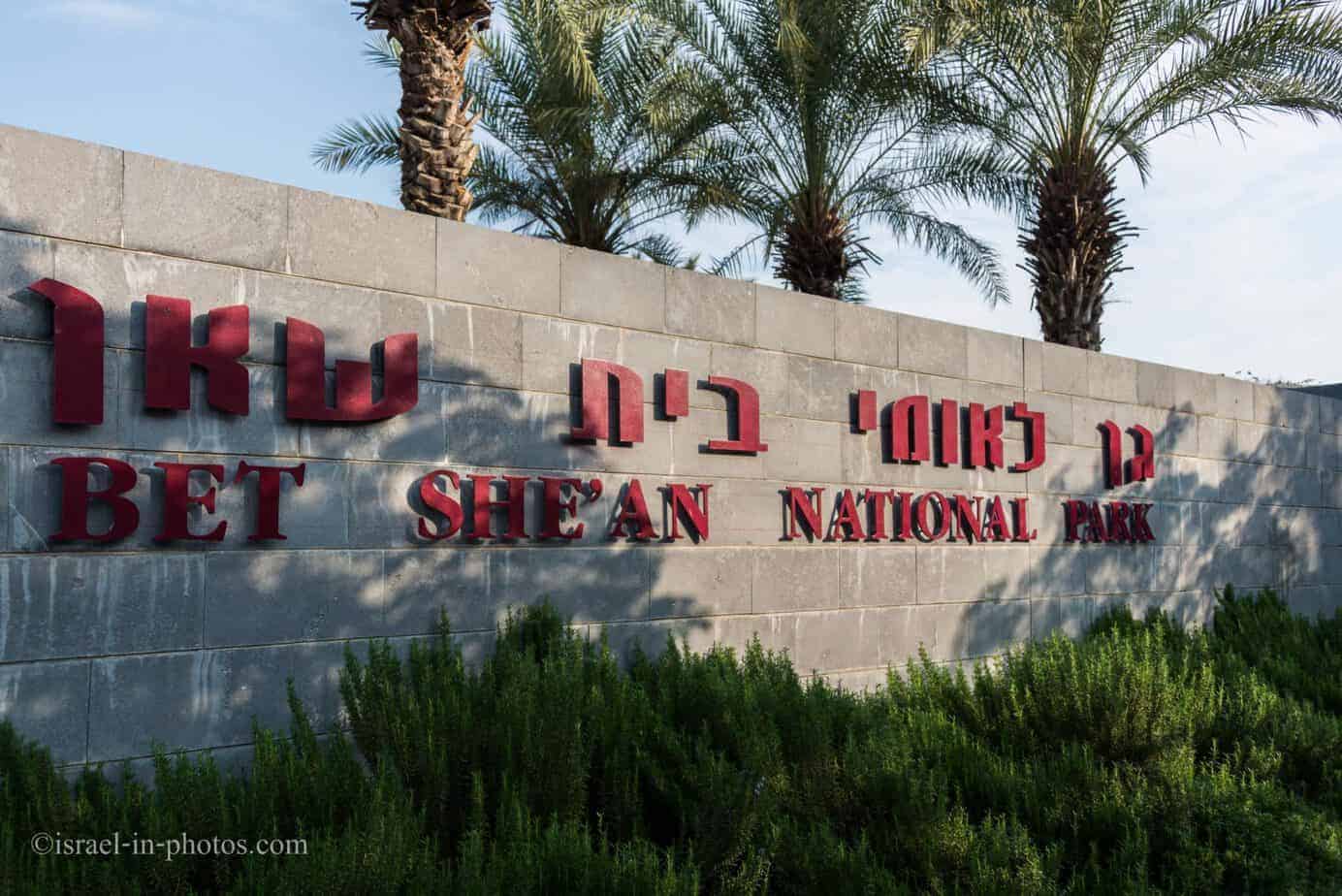
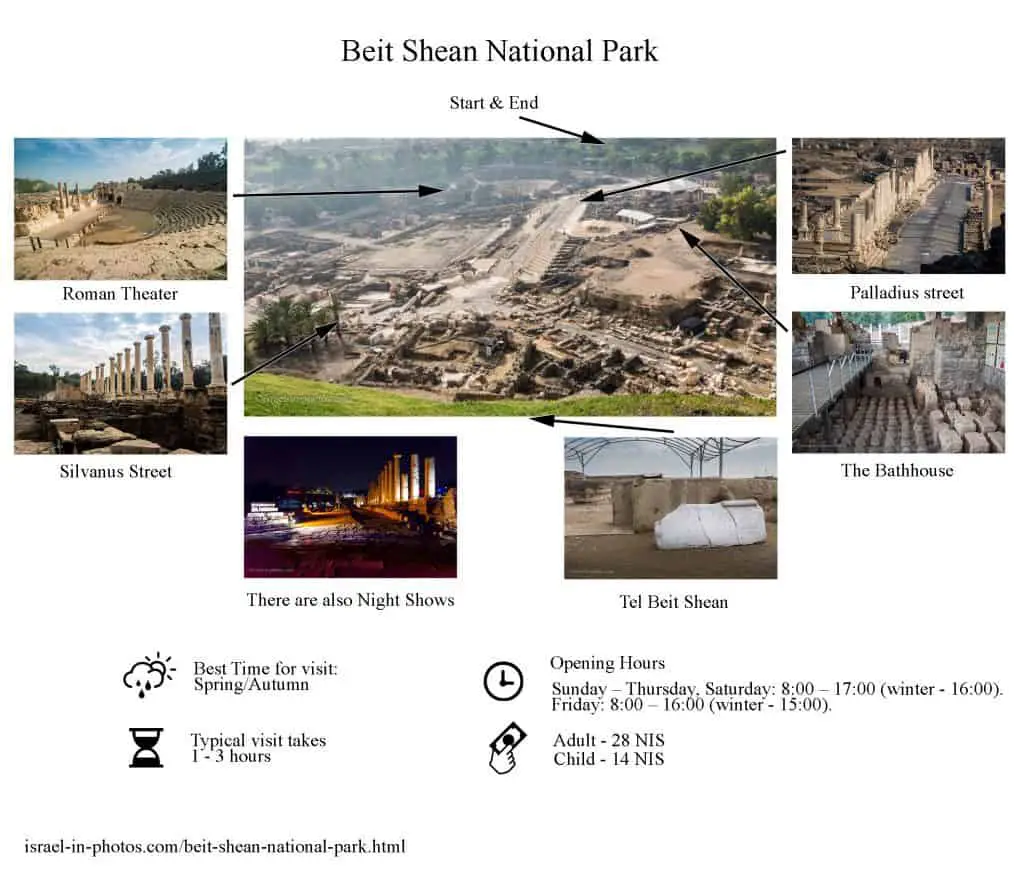
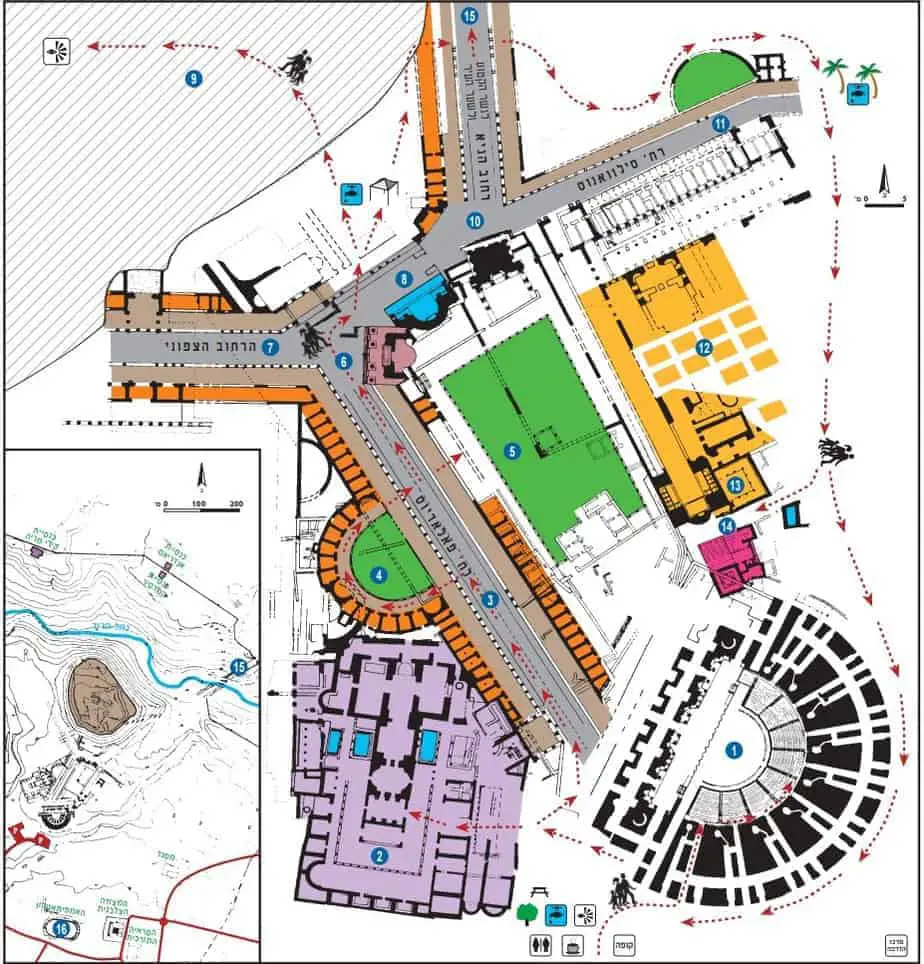

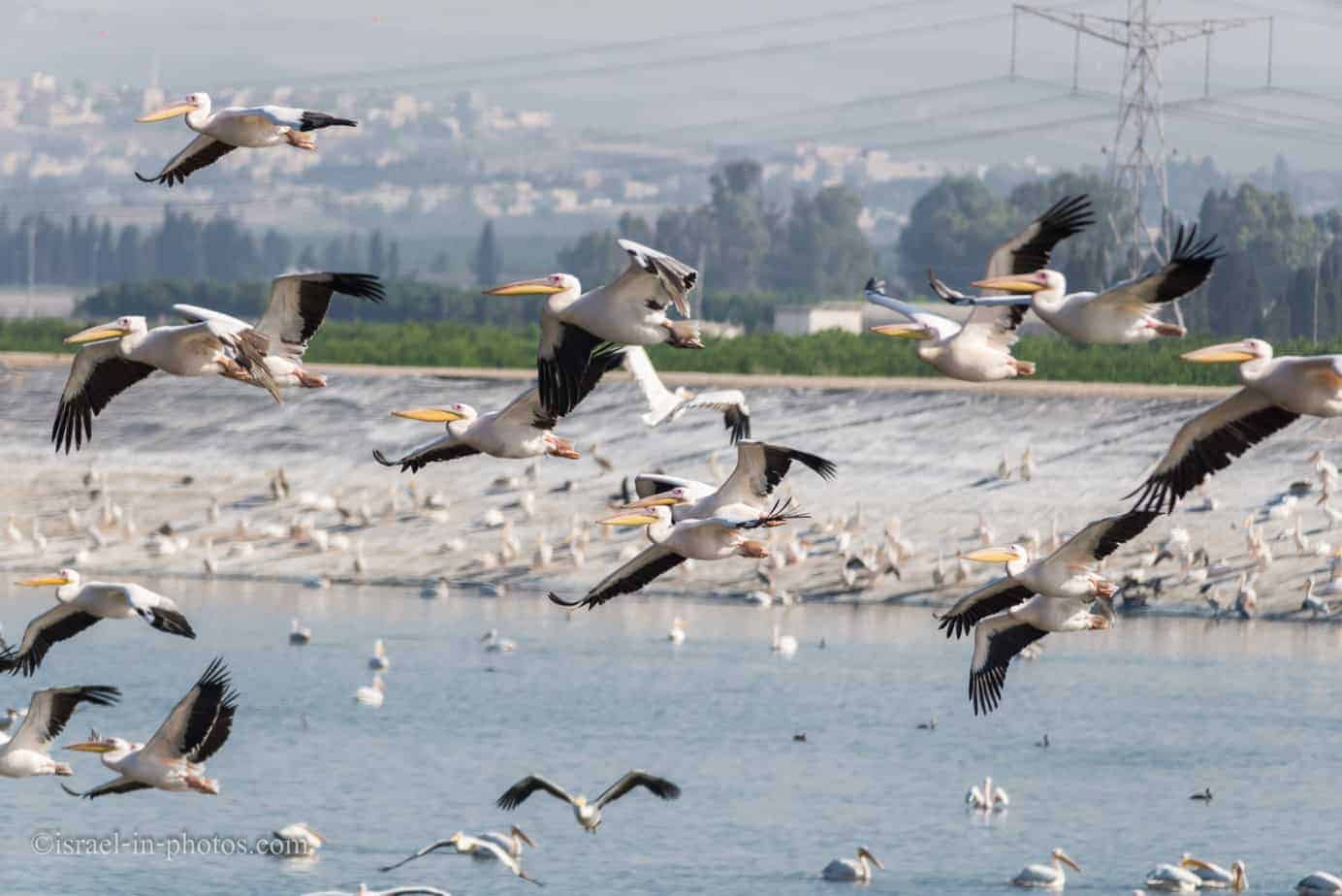


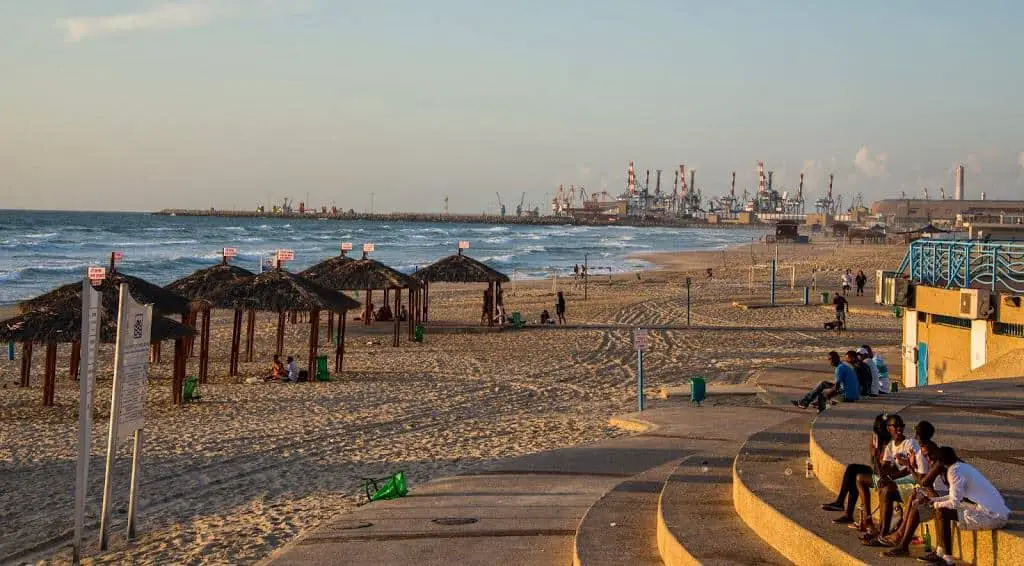

I really, really, enjoyed this. Thank you so much, I am always in awe when I see the ruins on ancient cities, especially Roman/Grecian.
I cannot wait to go to Israel one day, the only hard part is deciding which ruins to see since there are so many!
God bless!
Thank you! Beit Shean is the best preserved Roman city in Israel. I would recommend visiting it. Keep in mind, it gets boiling hot in this area. Thus preferably visiting early/late and not during hottest summer days.
If you like Roman remains then also check out Caesarea National Park at https://www.israel-in-photos.com/caesarea-national-park.html.
As I mentioned it the post, unfortunately due to insufficient funding they almost do not dig at the site. But there are many things that wait to be discovered. Several days ago two Roman statues were discovered by a Beit Shean resident. She took a stroll north of the ancient tell and noticed the top of a head of one of the statues (it was probably peeking after the rains washed the ground around it). For further reading check: https://www.jpost.com/Israel-News/Two-unique-Roman-statues-discovered-near-burial-site-in-ancient-Beit-Shean-575792
Thank you for such a thorough and excellent post. I will be there in a few weeks. How much time does it take to walk to the top of the tel? I’ve been tot he site before but never had time to make the climb. I’m thinking of trying to go to the top this time while others walk through the Roman ruins.
Hi Leo,
I’m glad you found it useful.
It will take you around 10 minutes depending on how fit you are.
While thinking about a more exact answer, I decided to check Google earth. According to it, the top of the Tel is at -130 meters, and Palladius Street is at -153 meters. Which means that the height of the tel is around 23 meters. If we assume that in a regular building, the height of each floor is about 3 meters, then this climb is equivalent to getting to the eights floor.
How much is entry fee to the Night Show and what time is it open till?
Entry fee to Shean Nights:
Adult: 55 NIS, child: 45 NIS
For the exact dates and times, you have to call them and make reservations. For more info, see: https://en.parks.org.il/new/%d7%9c%d7%99%d7%9c%d7%95%d7%aa-%d7%a9%d7%90%d7%9f-%d7%97%d7%95%d7%95%d7%99%d7%94-%d7%9c%d7%99%d7%9c%d7%99%d7%aa-%d7%a7%d7%a1%d7%95%d7%9e%d7%94/